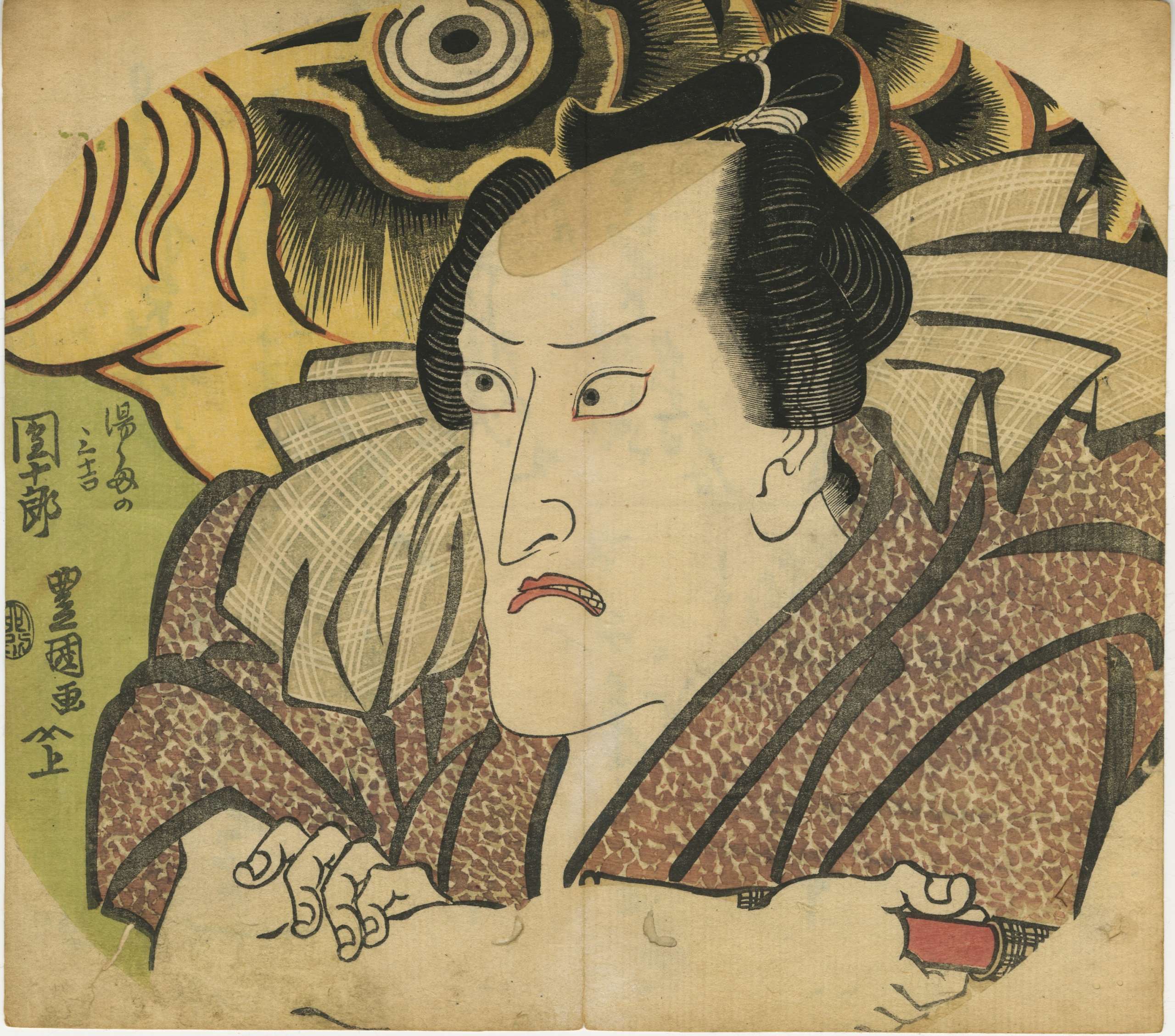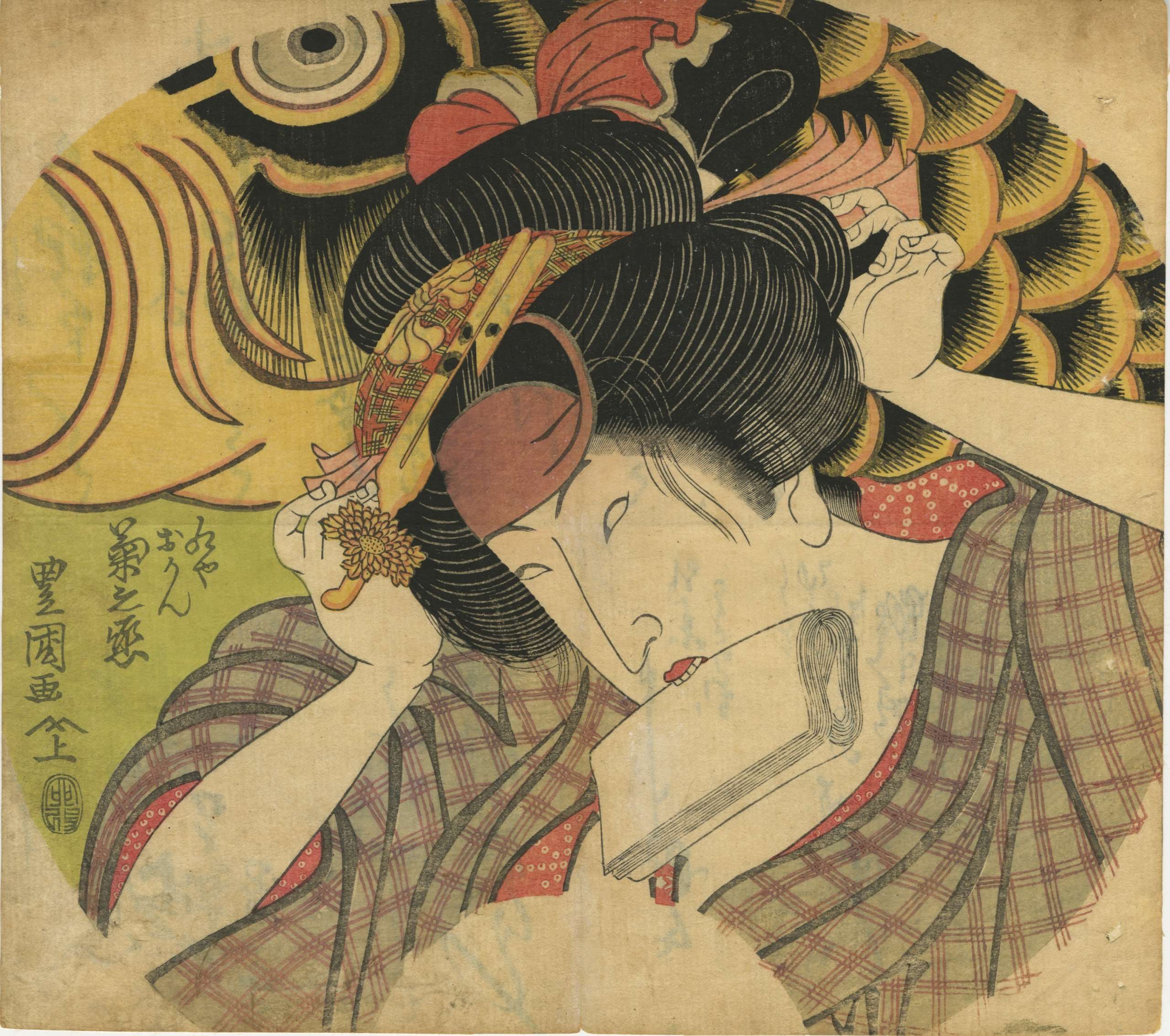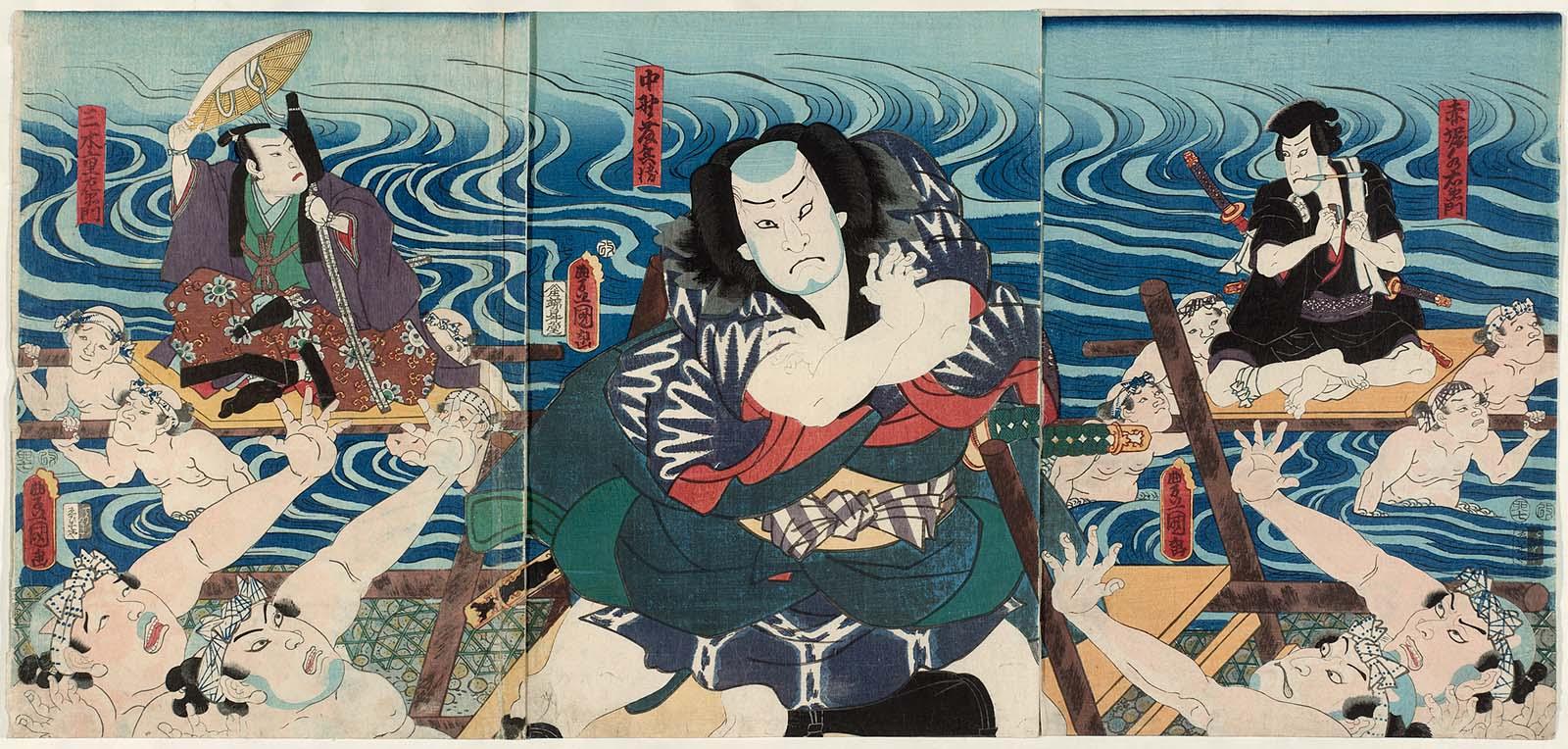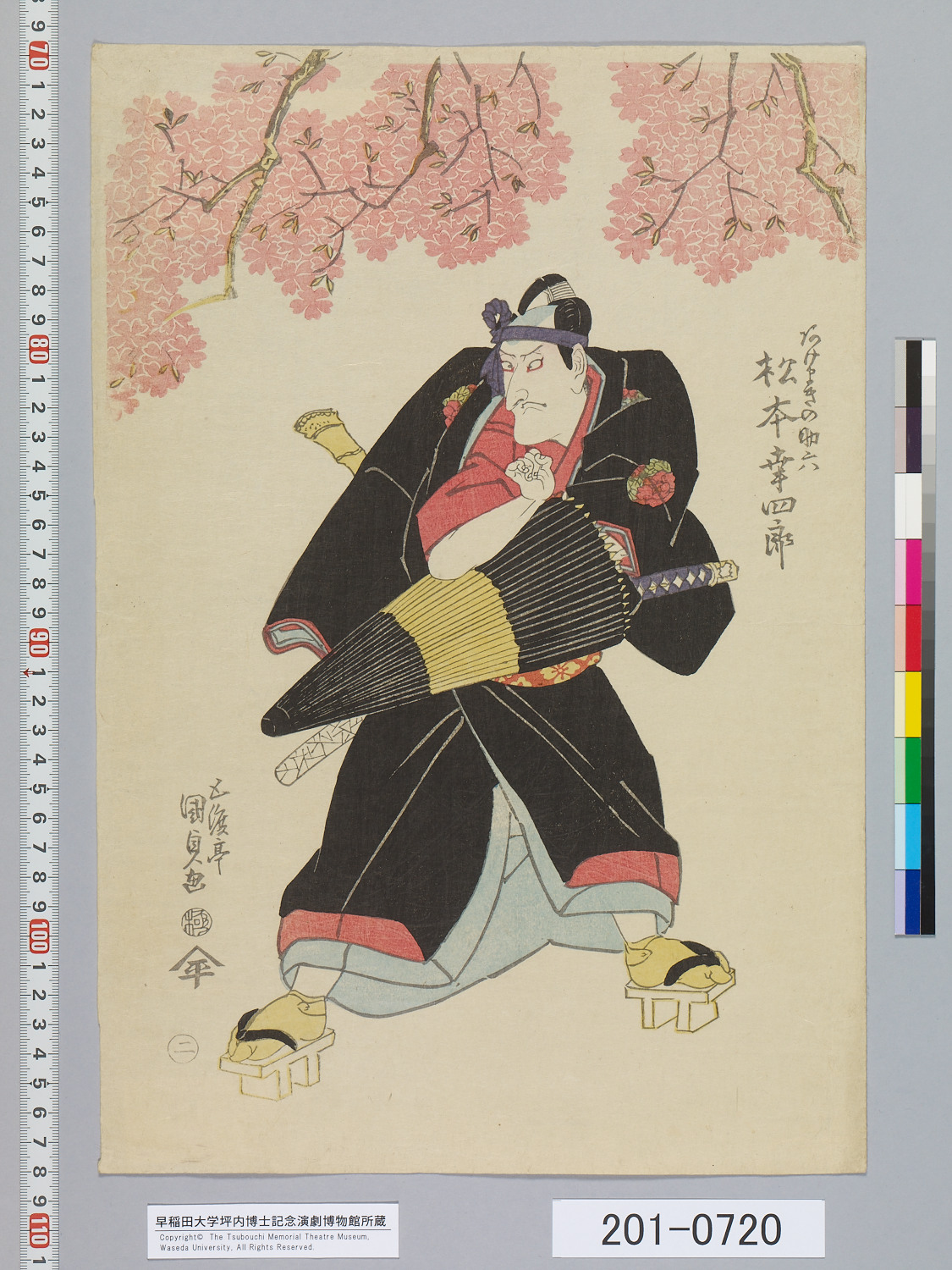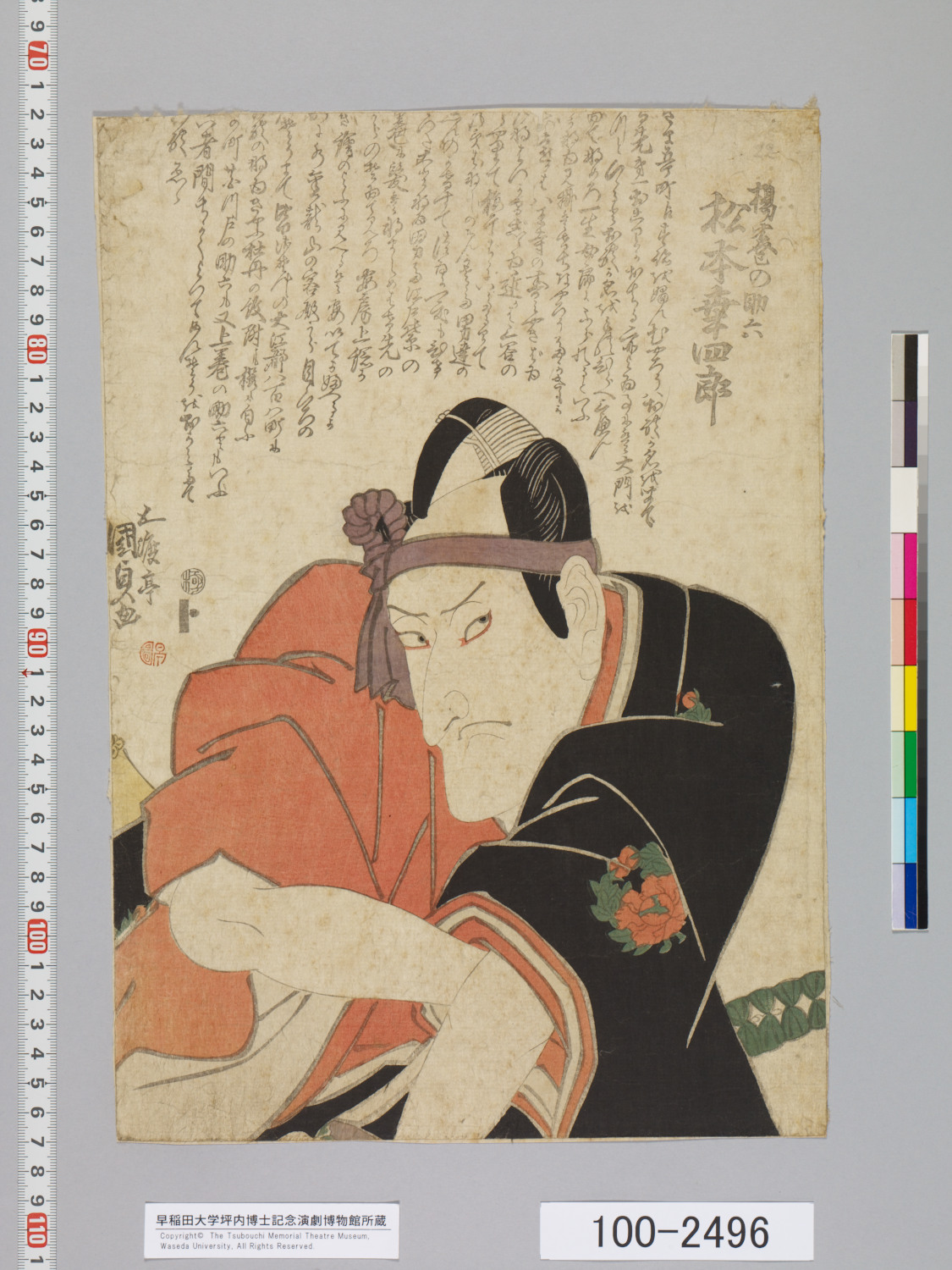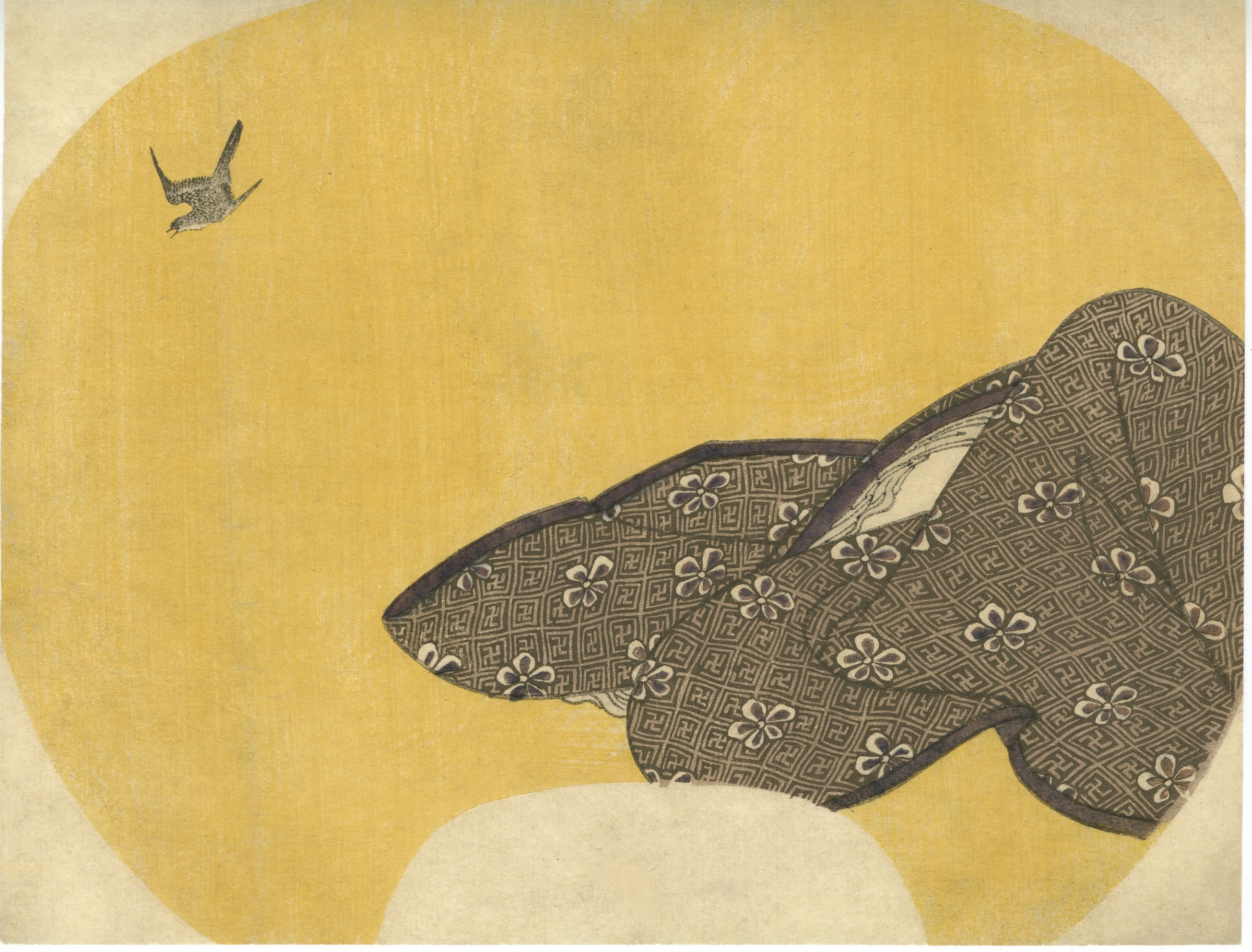 |
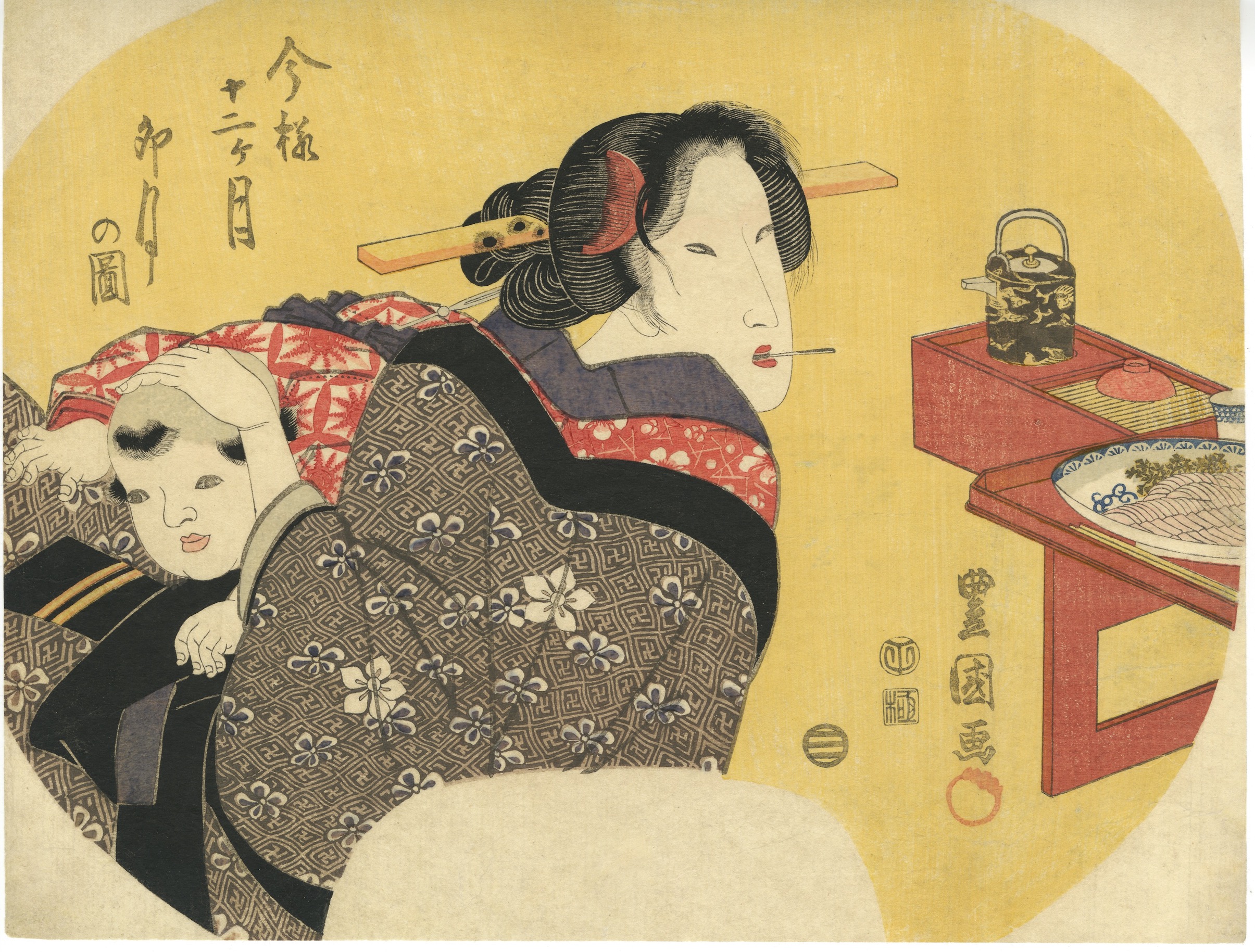 |
|---|
-
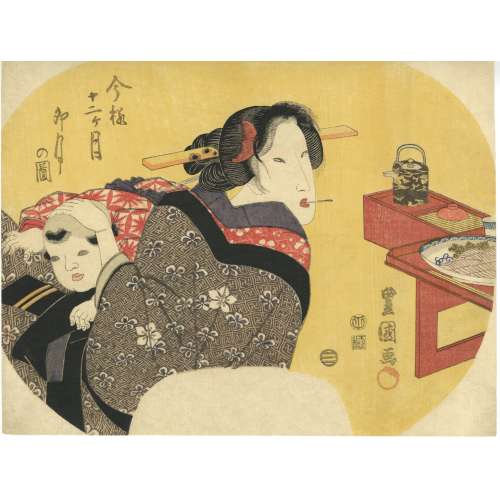 Title: Fourth lunar month [卯月] (Uzuki no zu); Series: Fashionable Twelve Months (Imayo juni-kagetsu). Another version of translation: Modern Beauties of Twelve Months. Artist: Utagawa Toyokuni I [歌川豊国] (1769–1825). Pubisher: Ibaya Senzaburō [伊場屋仙三郎] (Japanese, 1815 – 1869), seal: Dansendō [伊場仙]. Signed: Toyokuni ga and sealed with toshidama. Date-kiwame seal: Ushi (ox), Bunsei 5 (1822). Size: double-sheet uncut fan print ( aiban uchiwa-e), 219 x 295 mm.
Title: Fourth lunar month [卯月] (Uzuki no zu); Series: Fashionable Twelve Months (Imayo juni-kagetsu). Another version of translation: Modern Beauties of Twelve Months. Artist: Utagawa Toyokuni I [歌川豊国] (1769–1825). Pubisher: Ibaya Senzaburō [伊場屋仙三郎] (Japanese, 1815 – 1869), seal: Dansendō [伊場仙]. Signed: Toyokuni ga and sealed with toshidama. Date-kiwame seal: Ushi (ox), Bunsei 5 (1822). Size: double-sheet uncut fan print ( aiban uchiwa-e), 219 x 295 mm. -
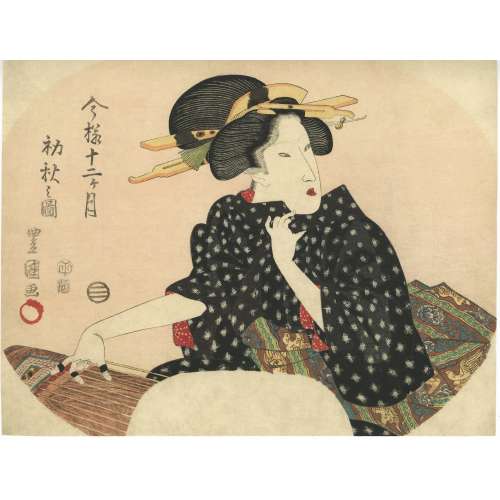 Title: Seventh lunar month [初秋] (Hatsuaki no zu); Series: Fashionable Twelve Months (Imayo juni-kagetsu). Another version of translation: Modern Beauties of Twelve Months. Artist: Utagawa Toyokuni I [歌川豊国] (1769–1825). Pubisher: Ibaya Senzaburō [伊場屋仙三郎] (Japanese, 1815 – 1869), seal: Dansendō [伊場仙]. Signed: Toyokuni ga and sealed with toshidama. Date-kiwame seal: Ushi (ox), Bunsei 5 (1822). Size: double-sheet uncut fan print ( aiban uchiwa-e), 219 x 295 mm.
Title: Seventh lunar month [初秋] (Hatsuaki no zu); Series: Fashionable Twelve Months (Imayo juni-kagetsu). Another version of translation: Modern Beauties of Twelve Months. Artist: Utagawa Toyokuni I [歌川豊国] (1769–1825). Pubisher: Ibaya Senzaburō [伊場屋仙三郎] (Japanese, 1815 – 1869), seal: Dansendō [伊場仙]. Signed: Toyokuni ga and sealed with toshidama. Date-kiwame seal: Ushi (ox), Bunsei 5 (1822). Size: double-sheet uncut fan print ( aiban uchiwa-e), 219 x 295 mm.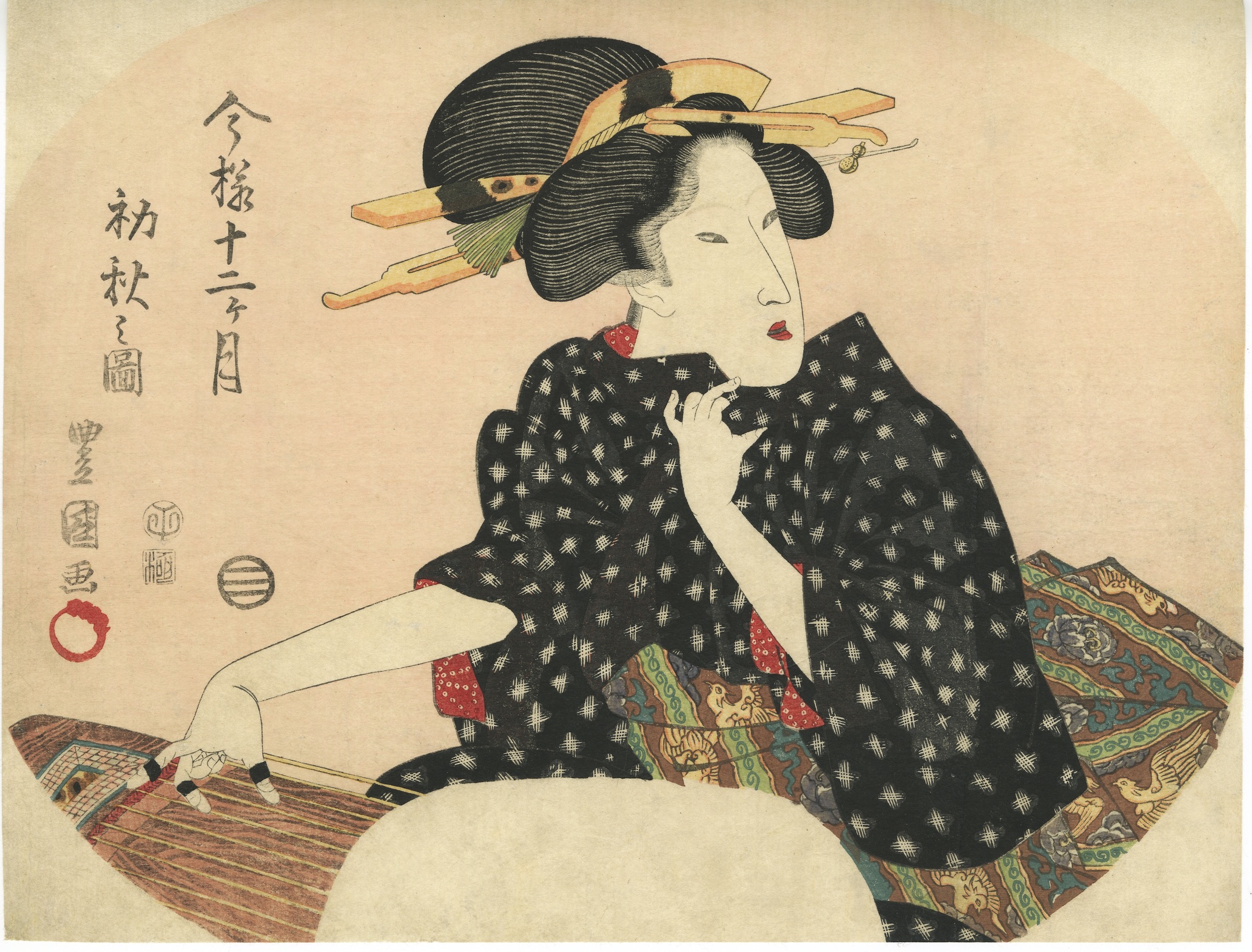
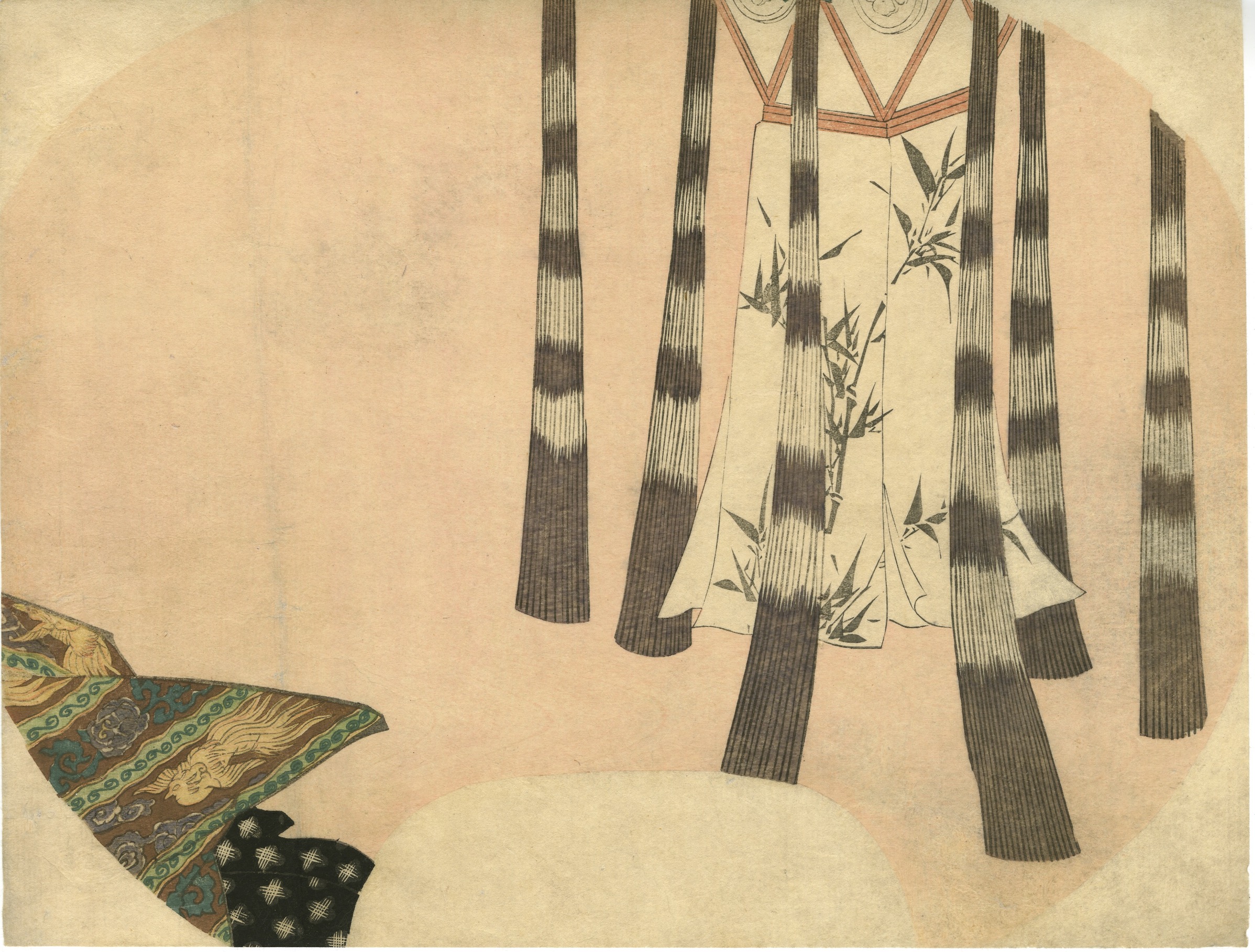
-
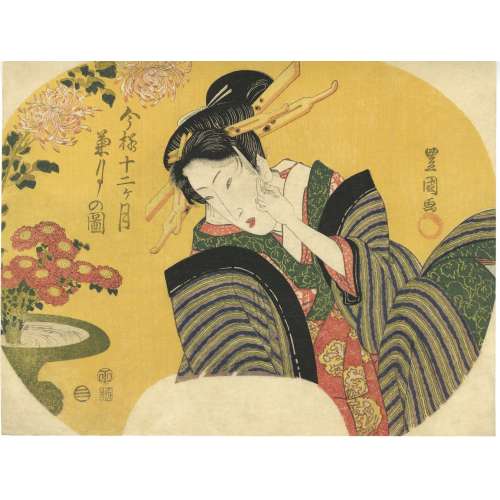 Title: Ninth lunar month [菊月] (Kikuzuki no zu); Series: Fashionable Twelve Months (Imayo juni-kagetsu). Another version of translation: Modern Beauties of Twelve Months. Artist: Utagawa Toyokuni I [歌川豊国] (1769–1825). Pubisher: Ibaya Senzaburō [伊場屋仙三郎] (Japanese, 1815 – 1869), seal: Dansendō [伊場仙]. Signed: Toyokuni ga and sealed with toshidama. Date-kiwame seal: Ushi (ox), Bunsei 5 (1822). Size: double-sheet uncut fan print ( aiban uchiwa-e), 219 x 295 mm.
Title: Ninth lunar month [菊月] (Kikuzuki no zu); Series: Fashionable Twelve Months (Imayo juni-kagetsu). Another version of translation: Modern Beauties of Twelve Months. Artist: Utagawa Toyokuni I [歌川豊国] (1769–1825). Pubisher: Ibaya Senzaburō [伊場屋仙三郎] (Japanese, 1815 – 1869), seal: Dansendō [伊場仙]. Signed: Toyokuni ga and sealed with toshidama. Date-kiwame seal: Ushi (ox), Bunsei 5 (1822). Size: double-sheet uncut fan print ( aiban uchiwa-e), 219 x 295 mm.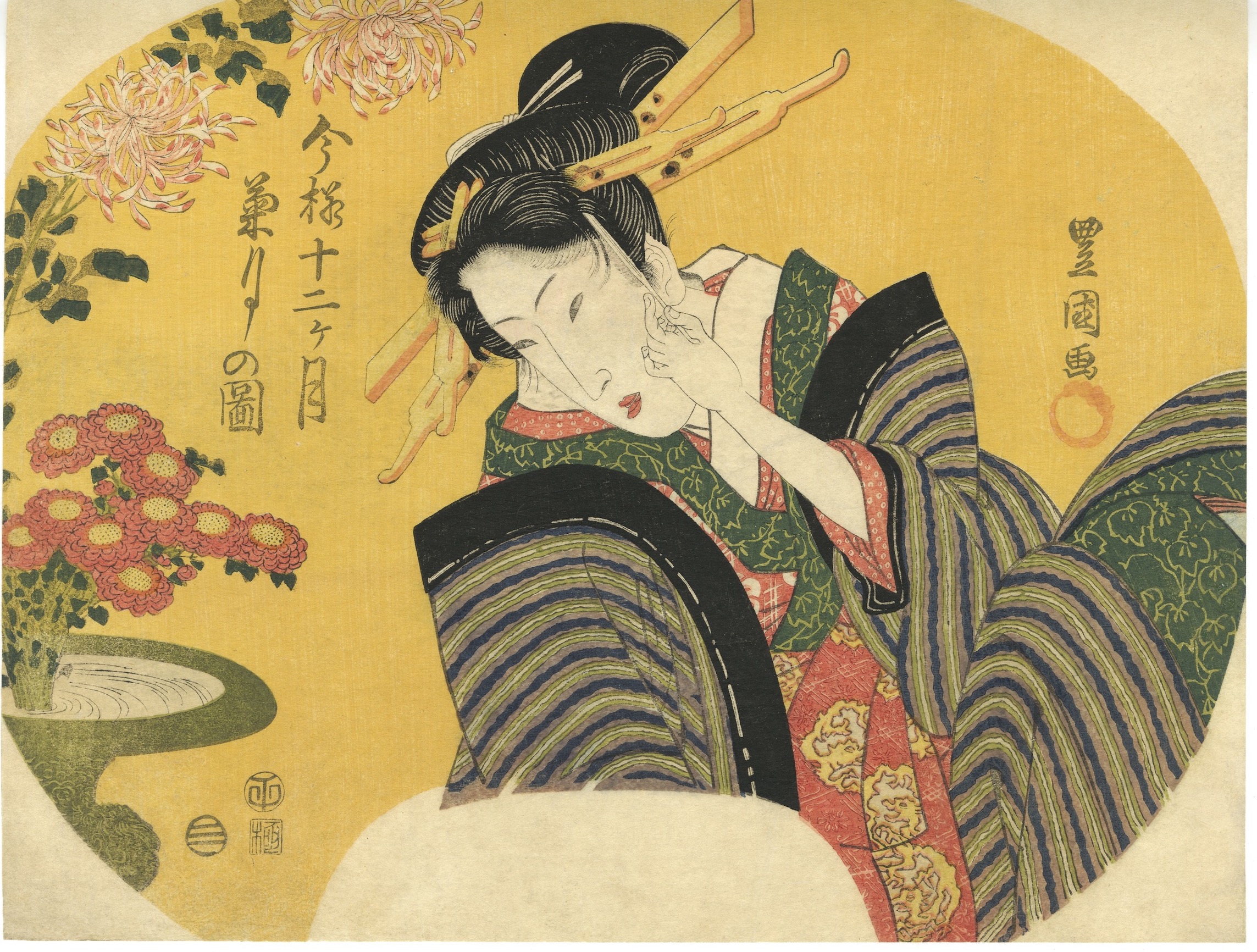
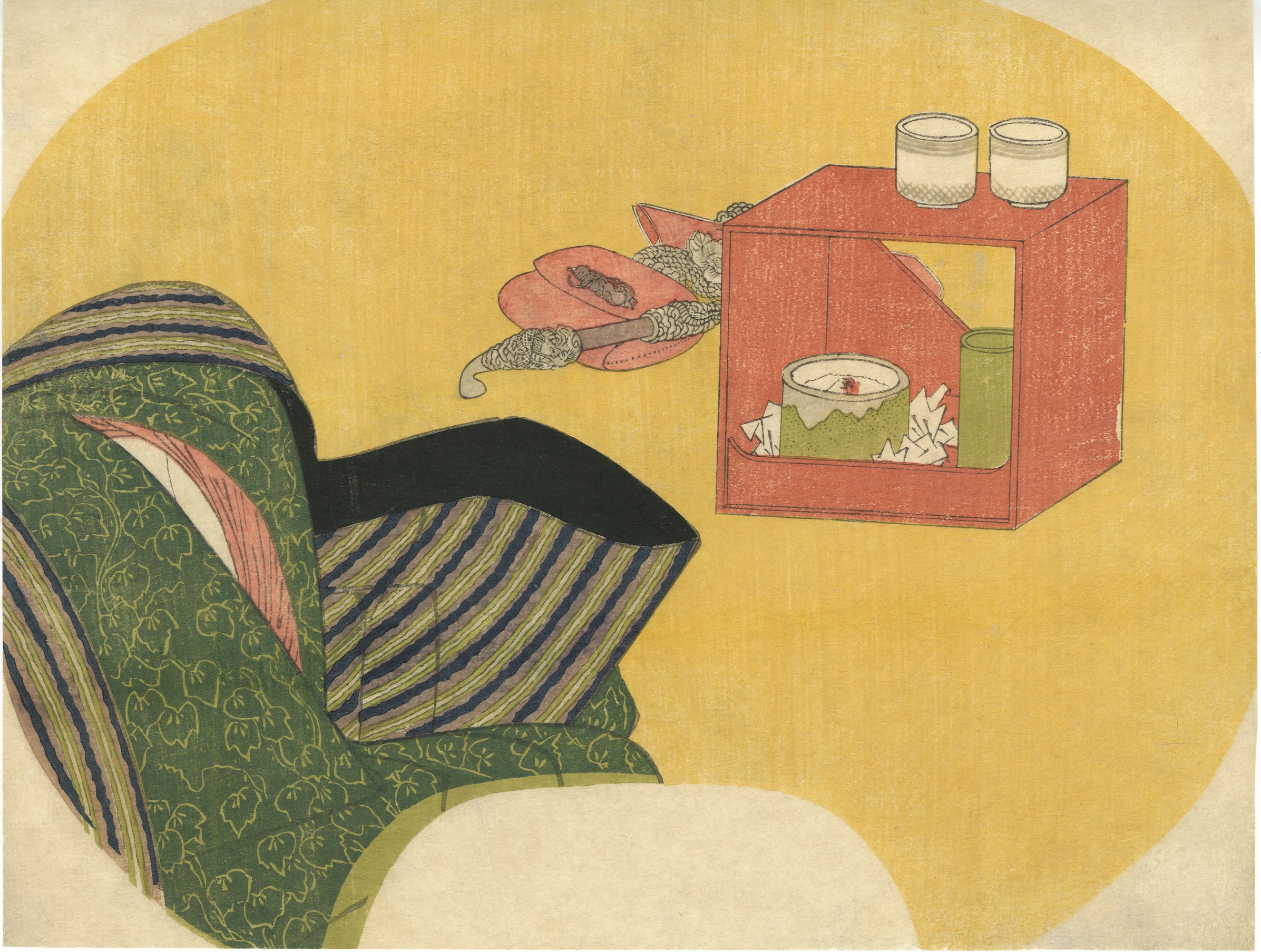
-
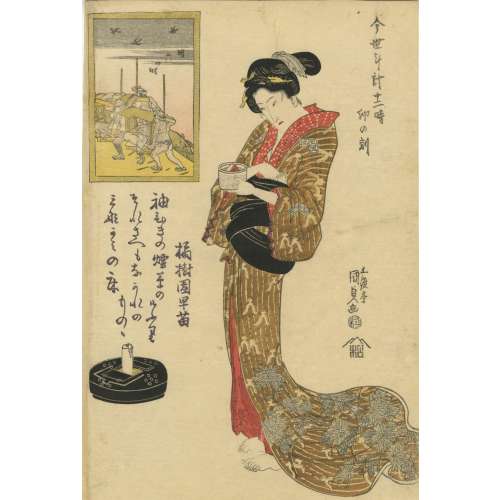 Artist: Utagawa Kunisada [歌川 国貞] a.k.a. Utagawa Toyokuni III [三代歌川豊国] (Japanese, 1786 – 1865). Publisher: Matsumura Tatsuemon [松村辰右衛門] (Japanese, fl. c. 1793 – 1832). Year: c. 1820–22 (Bunsei era). Signed: 五渡亭国貞画 – Gototei Kunisada ga. Censor's seal: kiwame 改印:極
Artist: Utagawa Kunisada [歌川 国貞] a.k.a. Utagawa Toyokuni III [三代歌川豊国] (Japanese, 1786 – 1865). Publisher: Matsumura Tatsuemon [松村辰右衛門] (Japanese, fl. c. 1793 – 1832). Year: c. 1820–22 (Bunsei era). Signed: 五渡亭国貞画 – Gototei Kunisada ga. Censor's seal: kiwame 改印:極
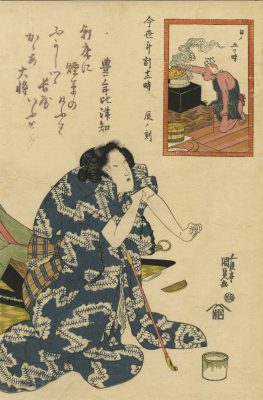
SVJP-0179-6.2014
The Hour of the Dragon, Fifth Hour of Day (Tatsu no koku, Hi no itsutsu toki), from the series Twelve Hours of a Modern Clock (Imayo tokei jūniji) 「今世時計十二時 辰ノ刻 日ノ五つ時」 MFA impression: 11.15315. 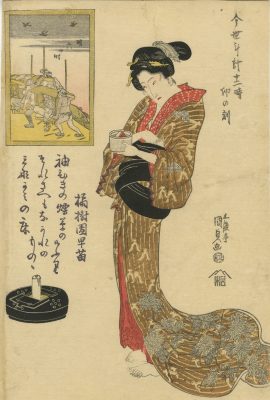
SVJP-0179-1.2014
The Hour of the Rabbit, Sixth Hour of Day (U no koku, Ake muttsu toki), from the series Twelve Hours of a Modern Clock (Imayo tokei jūniji) 「今世時計十二時 卯ノ刻 明六つ時」. MFA impression: 11.15317 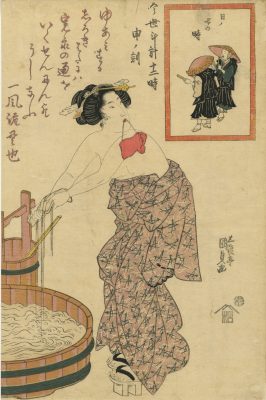
SVJP-0179-2.2014
The Hour of the Monkey, Seventh Hour of Day (Saru no koku, Hi no nanatsu toki), from the series Twelve Hours of a Modern Clock (Imayo tokei jūniji) 「今様時計十二時 申ノ刻 日ノ七つ時」 MFA impression: 11.39692 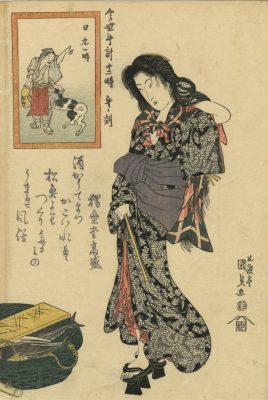
SVJP-0179-8.2014
The Hour of the Horse, Ninth Hour of Day (Uma no koku, Hi kokonotsu toki), from the series Twelve Hours of a Modern Clock (Imayo tokei jūniji) 「今世時計十二時 午ノ刻 日九つ時」. MFA impression: 11.15314 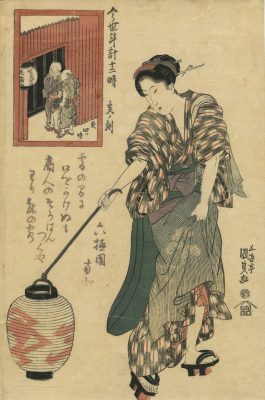
SVJP-0179-4.2014
The Hour of the Boar, Fourth Hour of Night (I no koku, Yoru yottsu toki), from the series Twelve Hours of a Modern Clock (Imayo tokei jūniji) 「今世時計十二時 亥ノ刻 夜四つ時」. MFA impression: 11.15552 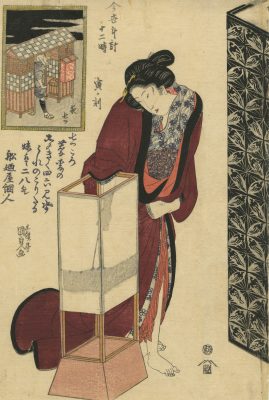
SVJP-0179-3.2014
The Hour of the Tiger, Seventh Hour of Night (Tora no koku, Yoru nanatsu), from the series Twelve Hours of a Modern Clock (Imayo tokei jūniji) 「今世時計十二時 寅ノ刻 夜七つ」. MFA impression: 11.15313 Ref.: Izzard. Kunisada’s world [LIB-2970.2022]. 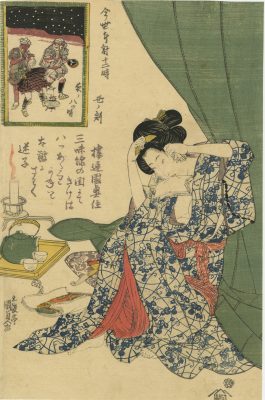
SVJP-0179-5.2014
The Hour of the Ox, Eight Hour of Night (Ushi no koku, Yoru no yattsu toki), from the series Twelve Hours of a Modern Clock (Imayo tokei jūniji) 「今世時計十二時 丑ノ刻 夜ノ八つ時」. MFA impression: 11.26906 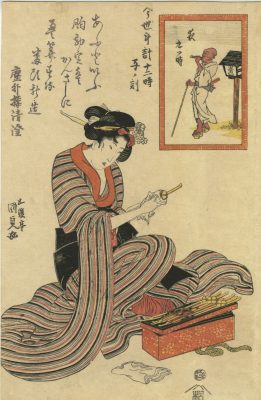
SVJP-0179-7.2014
The Hour of the Rat, Ninth Hour of Night (Ne no koku, Yoru kokonotsu toki), from the series Twelve Hours of a Modern Clock (Imayo tokei jūniji) 「今世時計十二時 子ノ刻 夜九つ時」. MFA impression: 11.15312 -
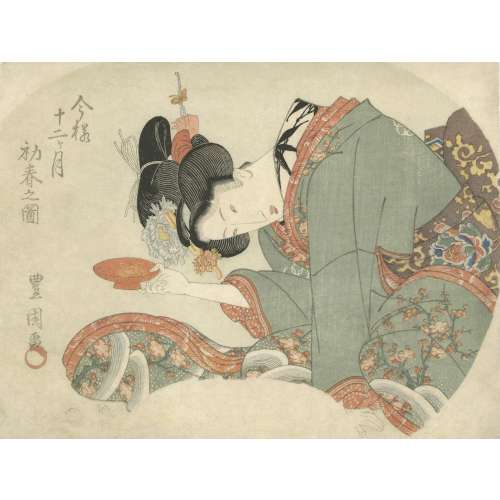 Title: Early Spring [初春之図] (Hatsuharu no zu); Series: Fashionable Twelve Months [今様十二ヶ月] (Imayo juni-kagetsu). Another version of translation: Modern Beauties of Twelve Months. Artist: Utagawa Toyokuni I [歌川豊国] (1769–1825). Pubisher: Ibaya Senzaburō [伊場屋仙三郎] (Japanese, 1815 – 1869), seal: Dansendō [伊場仙]. Signed: Toyokuni ga [豊国画] and sealed with toshidama. Date-kiwame seal: Ushi (ox), Bunsei 5 (1822). Size: double-sheet uncut fan print ( aiban uchiwa-e), each 217 x 288 mm. Ref: Tokyo Museum Collection.
Title: Early Spring [初春之図] (Hatsuharu no zu); Series: Fashionable Twelve Months [今様十二ヶ月] (Imayo juni-kagetsu). Another version of translation: Modern Beauties of Twelve Months. Artist: Utagawa Toyokuni I [歌川豊国] (1769–1825). Pubisher: Ibaya Senzaburō [伊場屋仙三郎] (Japanese, 1815 – 1869), seal: Dansendō [伊場仙]. Signed: Toyokuni ga [豊国画] and sealed with toshidama. Date-kiwame seal: Ushi (ox), Bunsei 5 (1822). Size: double-sheet uncut fan print ( aiban uchiwa-e), each 217 x 288 mm. Ref: Tokyo Museum Collection.
Other five prints of this series: SVJP 0326.2020; SVJP-0362.2022; SVJP-0363.2022; SVJP-0364.2022; SVJP-0365.2022.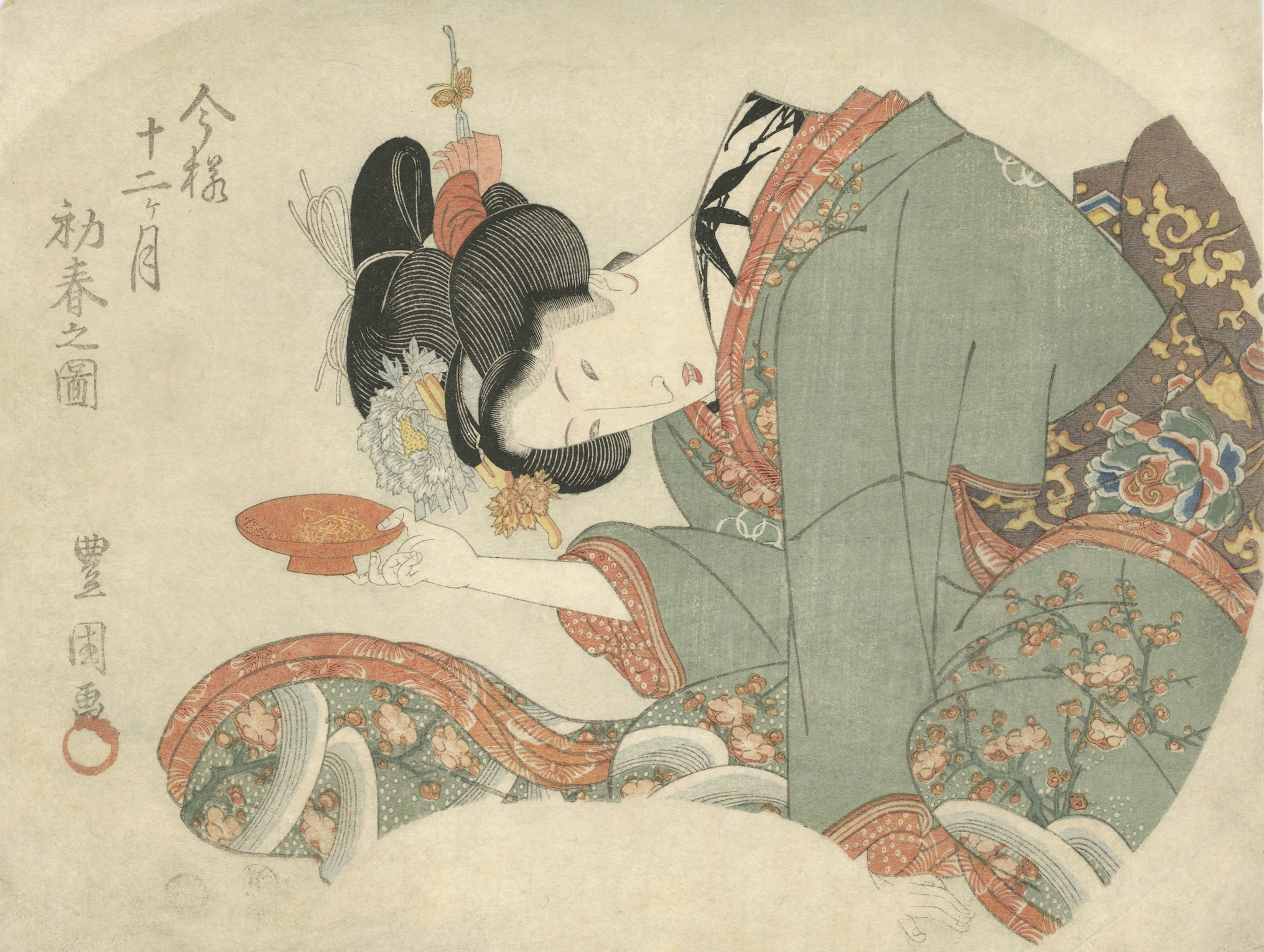
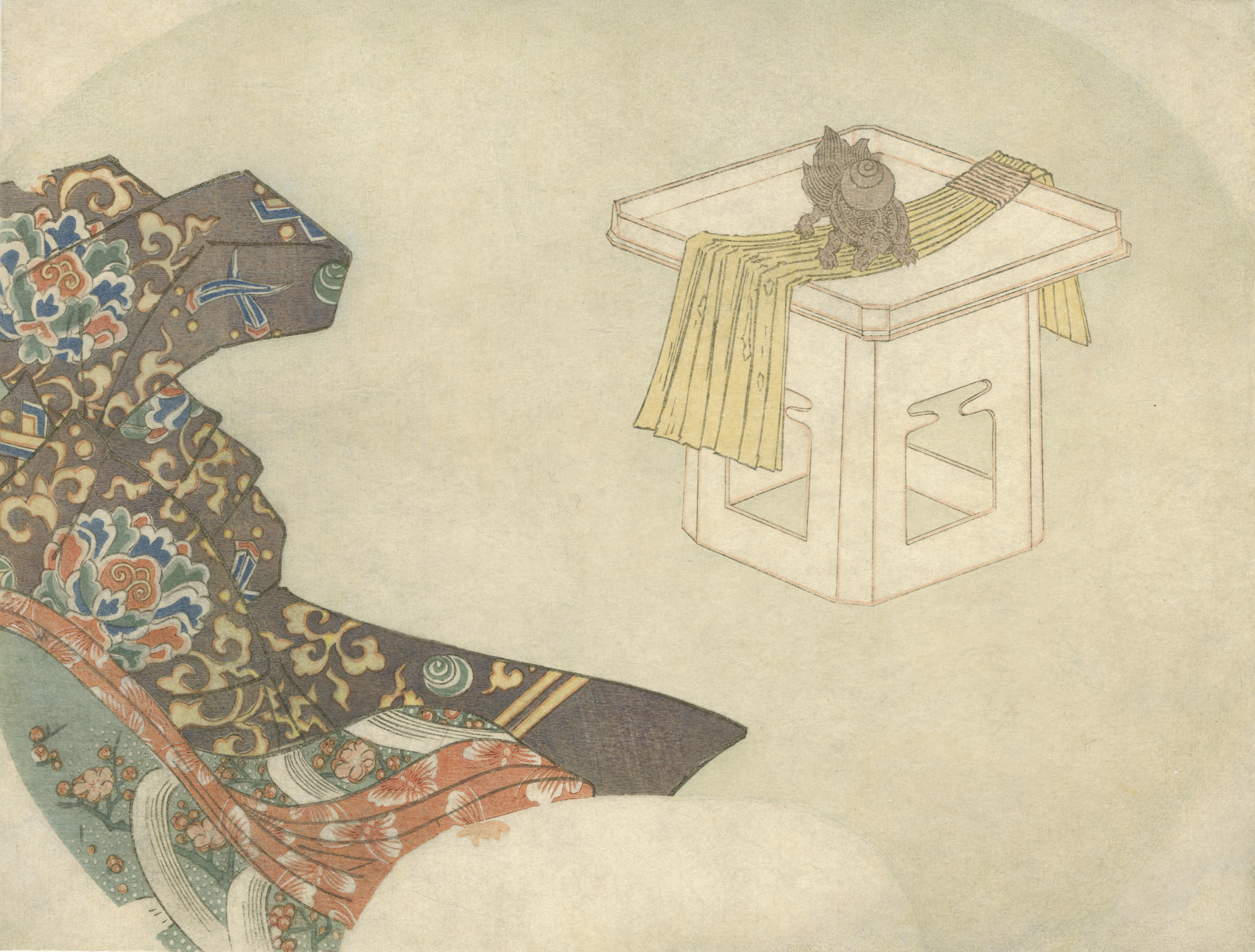
-
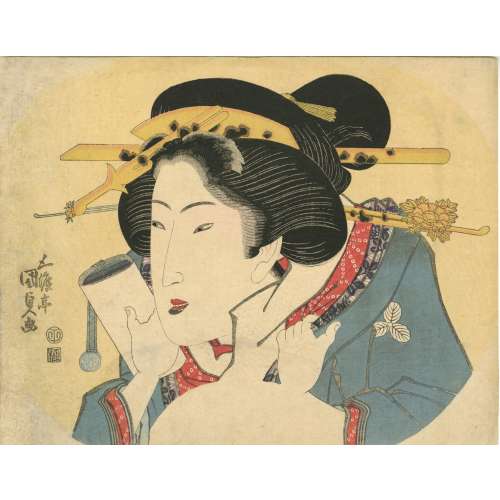 Artist: Utagawa Kunisada [歌川 国貞] a.k.a. Utagawa Toyokuni III [三代歌川豊国] (Japanese, 1786 – 1865). Pubisher (accorfding to Suzuki & Oka): Ibaya Senzaburō [伊場屋仙三郎] (Japanese, 1815 – 1869), Dansendō [伊場仙]. Title: Beauty holding a roll of paper (by seller); A woman of Edo (by Suzuki & Oka) Date seal and aratame censor seal: 1822 (Bunsei 5). Signed: Gototei Kunisada ga [五渡亭国貞画]. Media: Untrimmed fan print (uchiwa-e), 228 x 295 mm. Ref: [LIB-3085.2022] Jūzō Suzuki, Isaburō Oka. “The decadents”. — Tokyo: Kodansha International, 1969, p. 35, plate 30: exactly this print:
Artist: Utagawa Kunisada [歌川 国貞] a.k.a. Utagawa Toyokuni III [三代歌川豊国] (Japanese, 1786 – 1865). Pubisher (accorfding to Suzuki & Oka): Ibaya Senzaburō [伊場屋仙三郎] (Japanese, 1815 – 1869), Dansendō [伊場仙]. Title: Beauty holding a roll of paper (by seller); A woman of Edo (by Suzuki & Oka) Date seal and aratame censor seal: 1822 (Bunsei 5). Signed: Gototei Kunisada ga [五渡亭国貞画]. Media: Untrimmed fan print (uchiwa-e), 228 x 295 mm. Ref: [LIB-3085.2022] Jūzō Suzuki, Isaburō Oka. “The decadents”. — Tokyo: Kodansha International, 1969, p. 35, plate 30: exactly this print: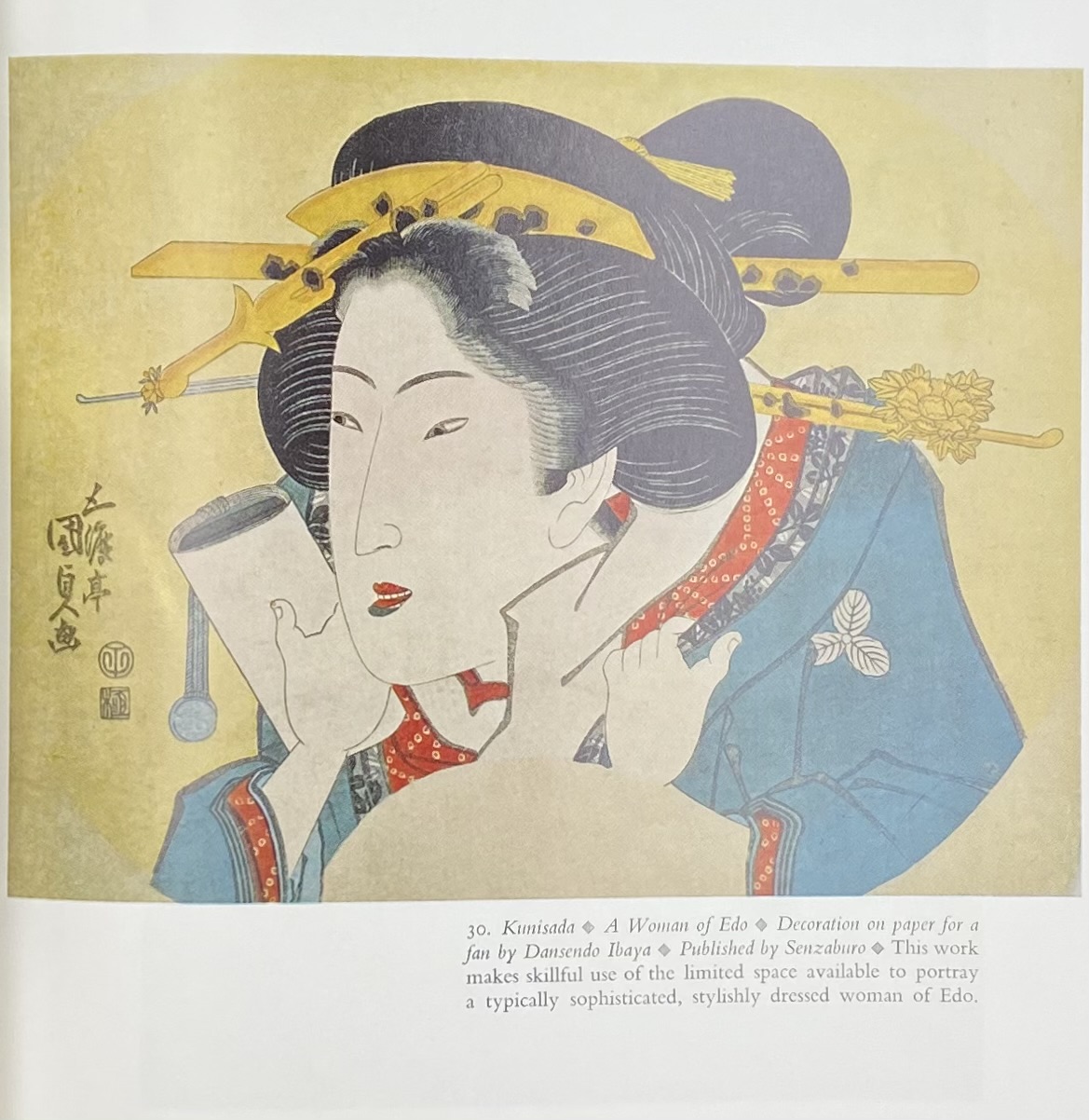
-
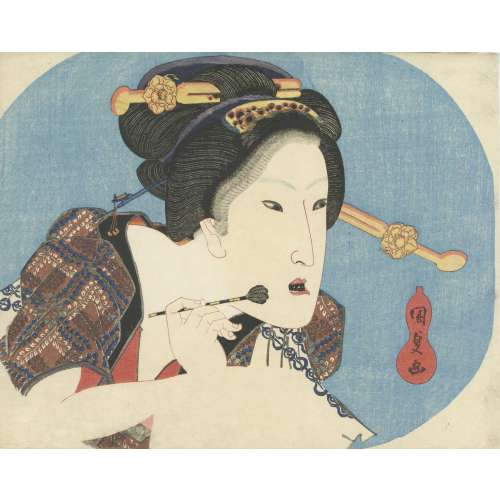 Artist: Utagawa Kunisada [歌川 国貞] a.k.a. Utagawa Toyokuni III [三代歌川豊国] (Japanese, 1786 – 1865). No publisher seal, no date or censor seal; probably a private printing. Signed: Kunisada ga [国貞画] in a red double gourd cartouche. Media: Untrimmed fan print (uchiwa-e), 231 x 294 mm, with the use of mica and black lacquer.
Artist: Utagawa Kunisada [歌川 国貞] a.k.a. Utagawa Toyokuni III [三代歌川豊国] (Japanese, 1786 – 1865). No publisher seal, no date or censor seal; probably a private printing. Signed: Kunisada ga [国貞画] in a red double gourd cartouche. Media: Untrimmed fan print (uchiwa-e), 231 x 294 mm, with the use of mica and black lacquer. -
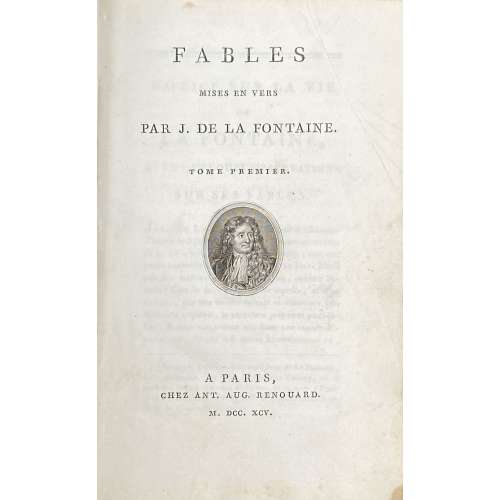 Two 8vo volumes bound in one, 19 x 12.5 cm, in full mottled sheepskin with gilt-bordered boards, gilt decorated flat spine with gilt-lettered red and black calf labels, rebacked, marbled endpapers and edges, printed on wove paper, plates on thicker laid paper. Title-page: FABLES | MISES EN VERS | PAR J. DE LA FONTAINE. | TOME PREMIER (SECOND). | {medallion portrait} (printer’s device “PC”) | A PARIS, | CHEZ ANT. AUG. RENOUARD. | M. DCC. XCV. || Collation: Vol. 1: π2 (h.t./imprint, t.p. medallion portrait/blank), [1]-38 (Notice sur la vie…), 1-58 64 (Vie de la Fontaine, Épitre, Préface, Vie d’Ésope), [7]-148 156 χ3 (table); pagination [4] [i] ii-xlviii, [1] 2-234. Total 143 leaves (286 pages) plus 6 plates after Moreau le Jeune by Devilliers fratres (p. 112), E. De Ghendt (pp. 122 and 181), Jean Louis Delignon (p. 140), Delvaux (p. 197), and Ph. Trière (p. 219). Title medallion portrait of La Fontaine (G Rigault pinx. – C S Gaucher inc.) by Gaucher after Rigaud. Vol. 2: π2 1-158 164; pagination [4] [1] 2-247 [248 blank]. Total 126 leaves (252 pages) plus 6 plates after Moreau le Jeune by Devilliers fratres (p. 19), Villerey (pp. 37, 80, and 146), Bosq (p. 121), and Ph. Trière (p. 199). The book published in 1795 (An 3) supplemented with plates produced in 1811 and 1812 for Œuvres complèttes (sic) de Jean de la Fontaine published by Lefèvre in 1814. The reason for choosing this particular edition for someone's library shortly after 1814 was probably the absence of censorship in 1795. Catalogue raisonné: (1) Lewine [LIB-2538.2020] on p. 276 (Paris, chez Renouard, 1795, 2 vols., 8vo., medal portrait on first title, and 12 plates after Moreau by Delvaux, Bosq, Ghendt, Trière, and Villerey). (2) M.-J.-F. Mahérault. L' oeuvre de Moreau le Jeune : catalogue raisonné et descriptif avec notes iconographiques et bibliographiques. — Paris: A. Labitte, 1880. Contributors: Jean de La Fontaine (French, 1621–1695) – author. Jean-Michel Moreau le Jeune (French, 1741–1814) – artist. Hyacinthe Rigaud (French, 1659 – 1743) – artist. Antoine-Augustin Renouard (French, 1765 – 1853) – publisher. Pierre Causse (French, 1761 – 1834) – printer. Engravers: Charles Étienne Gaucher (French, 1741 – 1804) Etienne De Villiers [Devilliers, Devilliers fratres] (French, 1784 – after 1844) Emmanuel Jean Nepomucène de Ghendt (Flemish, worked in France, 1738 – 1815) Jean-Louis Delignon (French, 1755 – 1820) Rémi Henri Joseph Delvaux (French, 1748 – 1823) Philippe Trière (French, 1756 – c. 1815) Auguste Villerey (French, 1801 – 1846) Jean Bosq (French, fl. c. 1801 – 1844)
Two 8vo volumes bound in one, 19 x 12.5 cm, in full mottled sheepskin with gilt-bordered boards, gilt decorated flat spine with gilt-lettered red and black calf labels, rebacked, marbled endpapers and edges, printed on wove paper, plates on thicker laid paper. Title-page: FABLES | MISES EN VERS | PAR J. DE LA FONTAINE. | TOME PREMIER (SECOND). | {medallion portrait} (printer’s device “PC”) | A PARIS, | CHEZ ANT. AUG. RENOUARD. | M. DCC. XCV. || Collation: Vol. 1: π2 (h.t./imprint, t.p. medallion portrait/blank), [1]-38 (Notice sur la vie…), 1-58 64 (Vie de la Fontaine, Épitre, Préface, Vie d’Ésope), [7]-148 156 χ3 (table); pagination [4] [i] ii-xlviii, [1] 2-234. Total 143 leaves (286 pages) plus 6 plates after Moreau le Jeune by Devilliers fratres (p. 112), E. De Ghendt (pp. 122 and 181), Jean Louis Delignon (p. 140), Delvaux (p. 197), and Ph. Trière (p. 219). Title medallion portrait of La Fontaine (G Rigault pinx. – C S Gaucher inc.) by Gaucher after Rigaud. Vol. 2: π2 1-158 164; pagination [4] [1] 2-247 [248 blank]. Total 126 leaves (252 pages) plus 6 plates after Moreau le Jeune by Devilliers fratres (p. 19), Villerey (pp. 37, 80, and 146), Bosq (p. 121), and Ph. Trière (p. 199). The book published in 1795 (An 3) supplemented with plates produced in 1811 and 1812 for Œuvres complèttes (sic) de Jean de la Fontaine published by Lefèvre in 1814. The reason for choosing this particular edition for someone's library shortly after 1814 was probably the absence of censorship in 1795. Catalogue raisonné: (1) Lewine [LIB-2538.2020] on p. 276 (Paris, chez Renouard, 1795, 2 vols., 8vo., medal portrait on first title, and 12 plates after Moreau by Delvaux, Bosq, Ghendt, Trière, and Villerey). (2) M.-J.-F. Mahérault. L' oeuvre de Moreau le Jeune : catalogue raisonné et descriptif avec notes iconographiques et bibliographiques. — Paris: A. Labitte, 1880. Contributors: Jean de La Fontaine (French, 1621–1695) – author. Jean-Michel Moreau le Jeune (French, 1741–1814) – artist. Hyacinthe Rigaud (French, 1659 – 1743) – artist. Antoine-Augustin Renouard (French, 1765 – 1853) – publisher. Pierre Causse (French, 1761 – 1834) – printer. Engravers: Charles Étienne Gaucher (French, 1741 – 1804) Etienne De Villiers [Devilliers, Devilliers fratres] (French, 1784 – after 1844) Emmanuel Jean Nepomucène de Ghendt (Flemish, worked in France, 1738 – 1815) Jean-Louis Delignon (French, 1755 – 1820) Rémi Henri Joseph Delvaux (French, 1748 – 1823) Philippe Trière (French, 1756 – c. 1815) Auguste Villerey (French, 1801 – 1846) Jean Bosq (French, fl. c. 1801 – 1844) -
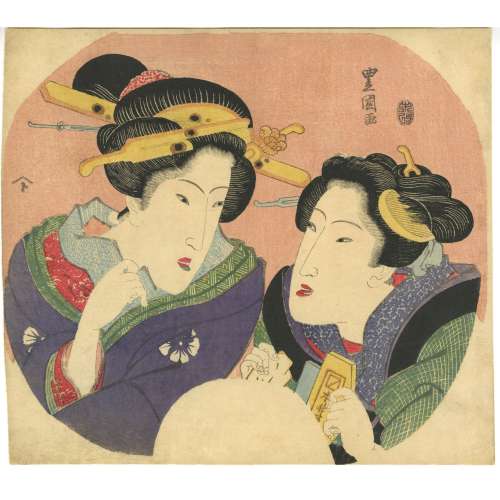 Artist: Utagawa Toyokuni I [歌川豊国] (1769–1825). Pubisher: Enshūya Matabei (遠州屋又兵衛) (c. 1768 – 1881), seal name: Enmata [ 遠又]. Signed: Toyokuni ga [豊国画]. Date-aratame censor seal: 未改, Bunsei 6 (1823). Size: uchiwa-e; 233 x 262 mm. Ref: Israel Goldman. Japanese Prints, Paintings and Books / Catalogue 28, 2022: № 14.
Artist: Utagawa Toyokuni I [歌川豊国] (1769–1825). Pubisher: Enshūya Matabei (遠州屋又兵衛) (c. 1768 – 1881), seal name: Enmata [ 遠又]. Signed: Toyokuni ga [豊国画]. Date-aratame censor seal: 未改, Bunsei 6 (1823). Size: uchiwa-e; 233 x 262 mm. Ref: Israel Goldman. Japanese Prints, Paintings and Books / Catalogue 28, 2022: № 14. -
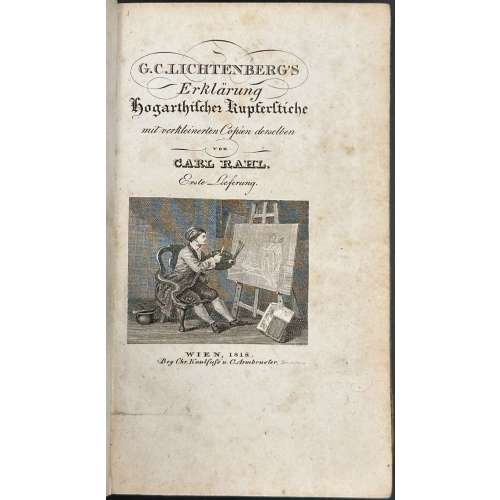 Three hardcover volumes, in-12mo, 16.2 x 10.6 cm each, uniformly bound in quarter brown cloth over marbled boards, all margins marbled, gilt lettering to spine; plus an oblong volume of similar binding, 24.5 x 39.5 cm, with 88 engraved plates by Riepenhausen after Hogarth (83 pp, unnumbered). Catalogue raisonné of William Hogarth's engravings, published by Carl Armbruster in Vienna and Dieterichsche Buchhandlung in Göttingen. A detailed explanation of Hogarth's prints divided in 14 parts. Vol. 1.
Three hardcover volumes, in-12mo, 16.2 x 10.6 cm each, uniformly bound in quarter brown cloth over marbled boards, all margins marbled, gilt lettering to spine; plus an oblong volume of similar binding, 24.5 x 39.5 cm, with 88 engraved plates by Riepenhausen after Hogarth (83 pp, unnumbered). Catalogue raisonné of William Hogarth's engravings, published by Carl Armbruster in Vienna and Dieterichsche Buchhandlung in Göttingen. A detailed explanation of Hogarth's prints divided in 14 parts. Vol. 1.- C. G. Lichtenberg’s Ausführliche Erklärung der Hogarthischen Kupferstiche, mit verkleinerten Copien derselben von Carl Rahl. Erste Lieferung. Wien, 1818. Bey Chr. Kaulfuß und C. Armbruster. Gedruckt bey Anton Strauß. [i-v] vi-xxxvi, [1-3] 4-136, plus engraved t.p.
- C. G. Lichtenberg’s Ausführliche Erklärung der Hogarthischen Kupferstiche, mit verkleinerten Copien derselben von Carl Rahl. Zweite Lieferung. Wien, 1818. Bey Chr. Kaulfuß und C. Armbruster. Gedruckt bey Anton Strauß. [i-iii] iv-viii [2] 11-207 [1 blank], plus engraved t.p.
- C. G. Lichtenberg’s Ausführliche Erklärung der Hogarthischen Kupferstiche, mit verkleinerten Copien derselben von Carl Rahl. Dritte Lieferung. Wien, 1818. Bey Chr. Kaulfuß und C. Armbruster. Gedruckt bey Anton Strauß. [i-iii] iv-vi [3] 10-215 [1 blank], plus engraved t.p.
- C. G. Lichtenberg’s Ausführliche Erklärung der Hogarthischen Kupferstiche, mit verkleinerten Copien derselben von Carl Rahl. Vierte Lieferung. Wien, 1818. Bey Chr. Kaulfuß und C. Armbruster. Gedruckt bey Anton Strauß. [1-5] 6-180 [1 blank], plus engraved t.p.
- C. G. Lichtenberg’s Ausführliche Erklärung der Hogarthischen Kupferstiche, mit verkleinerten Copien derselben von Carl Rahl. Fünste Lieferung. Wien, bey Carl Armbruster 1819. Gedruckt bey Anton Strauß. [1-3] 4-144, plus engraved t.p.
- C. G. Lichtenberg’s Ausführliche Erklärung der Hogarthischen Kupferstiche, mit verkleinerten Copien derselben von Carl Rahl. Sechste Lieferung. Mit zufåßen nach den schriften der englischen Erflårer. Wien, bey Carl Armbruster 1819. Gedruckt bey Anton Strauß. [i-iii] iv-x [2] 13-100, plus engraved t.p.
- C. G. Lichtenberg’s Ausführliche Erklärung der Hogarthischen Kupferstiche, mit verkleinerten Copien derselben von Carl Rahl. Siebente und achte Lieferung. Mit zufåßen nach den Schriften der englischen Erflårer. Wien, bey Carl Armbruster 1820. Gedruckt bey Anton Strauß. [1-8] 9-191, plus engraved t.p.
- C. G. Lichtenberg’s Ausführliche Erklärung der Hogarthischen Kupferstiche, mit verkleinerten Copien derselben von Carl Rahl. Neunte und zehnte Lieferung. Mit zufåßen nach den Schriften der englischen Erflårer. Wien, bey Carl Armbruster 1823. Gedruckt bey Anton Strauß. [1-7] 8-168, plus engraved t.p.
- C. G. Lichtenberg’s Erklärung der Hogarthischen Kupferstiche, mit verkleinerten aber vollständigen Copien derselben von E. Riepenhausen. Eilfte Lieferung mit zufåßen nach den schriften der englischen Erflårer. Göttingen in der Dieterichsche Buchhandlung 1809. [1-3] 4-81 [82 blank].
- C. G. Lichtenberg’s Ausführliche Erklärung der Hogarthischen Kupferstiche, mit verkleinerten aber vollständigen Copien derselben von E. Riepenhausen fortgefeßt vom Berausgeber der fechsten Lieferung mit Benußung der englischen Erflårer. Zwölfte Lieferung. Göttingen in der Dieterichsche Buchhandlung 1816. [i-iii] iv [1-3] 4-76.
- J. P. Lyser’s Ausführliche Erklärung der Hogarthischen Kupferstiche, mit verkleinerten aber vollständigen Copien derselben von E. Riepenhausen. Dreizehnte Lieferung Göttingen in der Dieterichsche Buchhandlung 1833. [i-v] vi-xii, [1-3] 4-117 [118].
- Dr. le Petit’s Ausführliche Erklärung der Hogarthischen Kupferstiche, mit verkleinerten aber vollständigen Copien derselben von E. Riepenhausen, Berausgeber Karl Gutzkow. Vierzehnte Lieferung. Göttingen in der Dieterichsche Buchhandlung 1835. [i-iii] iv-xvi, [1-3] 4-132.
-
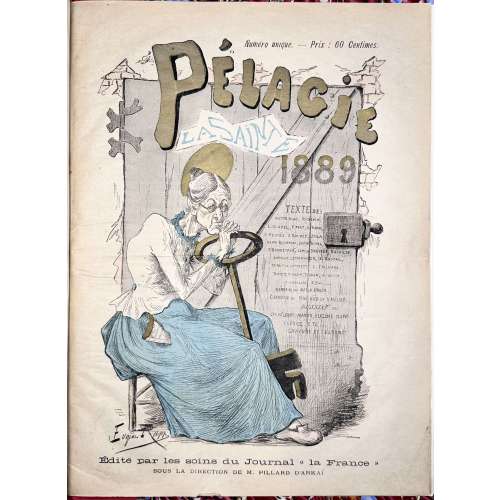 Convolute: Pélagie la sainte. Quarter red buckram over marbled papers with brown gilt-lettered calf label to spine, 399 x 290 mm. Consists of: One blank leaf
Convolute: Pélagie la sainte. Quarter red buckram over marbled papers with brown gilt-lettered calf label to spine, 399 x 290 mm. Consists of: One blank leaf- Gérard de Nerval. Mémoires d'un parisien: Sainte-Pélagie, en. 1832. Published in L'Artiste : journal de la littérature et des beaux-arts 1841 (SER2,T7). L'ARTISTE, | JOURNAL DE LA LITTÉRATURE ET DES BEAUX-ARTS. | 2° Série. – Tome 6 (ms pencil 7 et 8) | {vignette signed M. ALOPHE} | PARIS. | AUX BUREAUX DE L'ARTISTE, RUE DE SEINE-SAINT-GERMAIN, 39 | 1840. (crossed out, ms pencil 1841) || Engraved title, h.t./imprint, t.p., pp. 251-256 (six leaves); p. 252-5:
- Talon / Maison de Sainte-Pélagie November 18, 1822 (One leaf)
- Maxime du Camp. Les prisons de Paris. Published in: Revue de deux mondes, 83, № 3 (1eroctobre 1869), pp. [598]-634 (17 leaves).
- Philibert Audebrand. La Gazette de Sainte-Pélagie. Published in: L'Intermédiaire des chercheurs et curieux, № 518, 10 Dec 1889, p. 711. (Newspaper clip).
- Pélagie la Sainte 1889. Numero unique. Edité par les soins du Journal « la France » | SOUS LA DIRECTION DE M. PILLARD D'ARKAÏ || Title engraved on wood and hand-painted. Texts by Paul Adam, Paul Bonnetain, Simon Boubée, Léon Cladel, Camille Dreyfus, Ch. Gilbert-Martin, Victor Hugo, Camille Lemonnier, Maurice Mac-Nab, Louise Michel, Félix Pyat, Rachilde, Xavier Raspail, Jean Richepin, Henri Rochefort, Laurent Tailhade, Émile Zola, etc. Illustrations by Ch. Clérice, Ch. Gilbert-Martin, Alfred Le Petit, Eugène Rapp. Pp. 1-24 (12 leaves). Gallica: Pélagie la sainte, 1889 / [signé Pillard d'Arkaï]
-
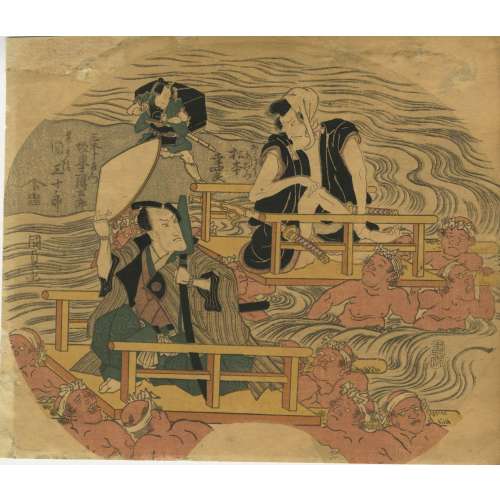 Artist: Utagawa Kunisada, a.k.a. Toyokuni III (Japanese, 1786 – 1865) [歌川 国貞]. Publisher: Unidentified, Marks 01-033|U335a To-Chū [ト忠] Date-aratame seal: Bunka 14 (1817). Signed: Kunisada ga [国貞画]. Media: Fan print (uchiwa-e), 230 x 270 mm. Kabuki play Chūkō shōbu-gatana [忠孝菖蒲刀] performed at the Nakamura Theater in Tokyo (Edo) in 5/1817. Actor Seki Sanjūrō II [関三十郎], a.k.a. Seki Utasuke I; Nakamura Utasuke; Arashi Sôtarô; Meijin Seki; Sekisan (Japanese, 1786 – 1839) as Nakano Tōbei [中野藤兵衛] – top. Actor Bandō Mitsugorō III [坂東三津五郎], a.k.a. Bandô Minosuke I, Morita Kanjirô II, Bandô Mitahachi I, Bandô Minosuke I, Bandô Mitahachi (Japanese, 1775 – 1831) I as Miki Jūzaemon [三木十左衛門] – left. Actor Matsumoto Kōshirō V [松本幸四郎], a.k.a. Ichikawa Komazô III; Ichikawa Sumizô I (Japanese, 1764 – 1838) as Akabori Mizuemon [あかぼり水右衛門] – right. Reference images:
Artist: Utagawa Kunisada, a.k.a. Toyokuni III (Japanese, 1786 – 1865) [歌川 国貞]. Publisher: Unidentified, Marks 01-033|U335a To-Chū [ト忠] Date-aratame seal: Bunka 14 (1817). Signed: Kunisada ga [国貞画]. Media: Fan print (uchiwa-e), 230 x 270 mm. Kabuki play Chūkō shōbu-gatana [忠孝菖蒲刀] performed at the Nakamura Theater in Tokyo (Edo) in 5/1817. Actor Seki Sanjūrō II [関三十郎], a.k.a. Seki Utasuke I; Nakamura Utasuke; Arashi Sôtarô; Meijin Seki; Sekisan (Japanese, 1786 – 1839) as Nakano Tōbei [中野藤兵衛] – top. Actor Bandō Mitsugorō III [坂東三津五郎], a.k.a. Bandô Minosuke I, Morita Kanjirô II, Bandô Mitahachi I, Bandô Minosuke I, Bandô Mitahachi (Japanese, 1775 – 1831) I as Miki Jūzaemon [三木十左衛門] – left. Actor Matsumoto Kōshirō V [松本幸四郎], a.k.a. Ichikawa Komazô III; Ichikawa Sumizô I (Japanese, 1764 – 1838) as Akabori Mizuemon [あかぼり水右衛門] – right. Reference images: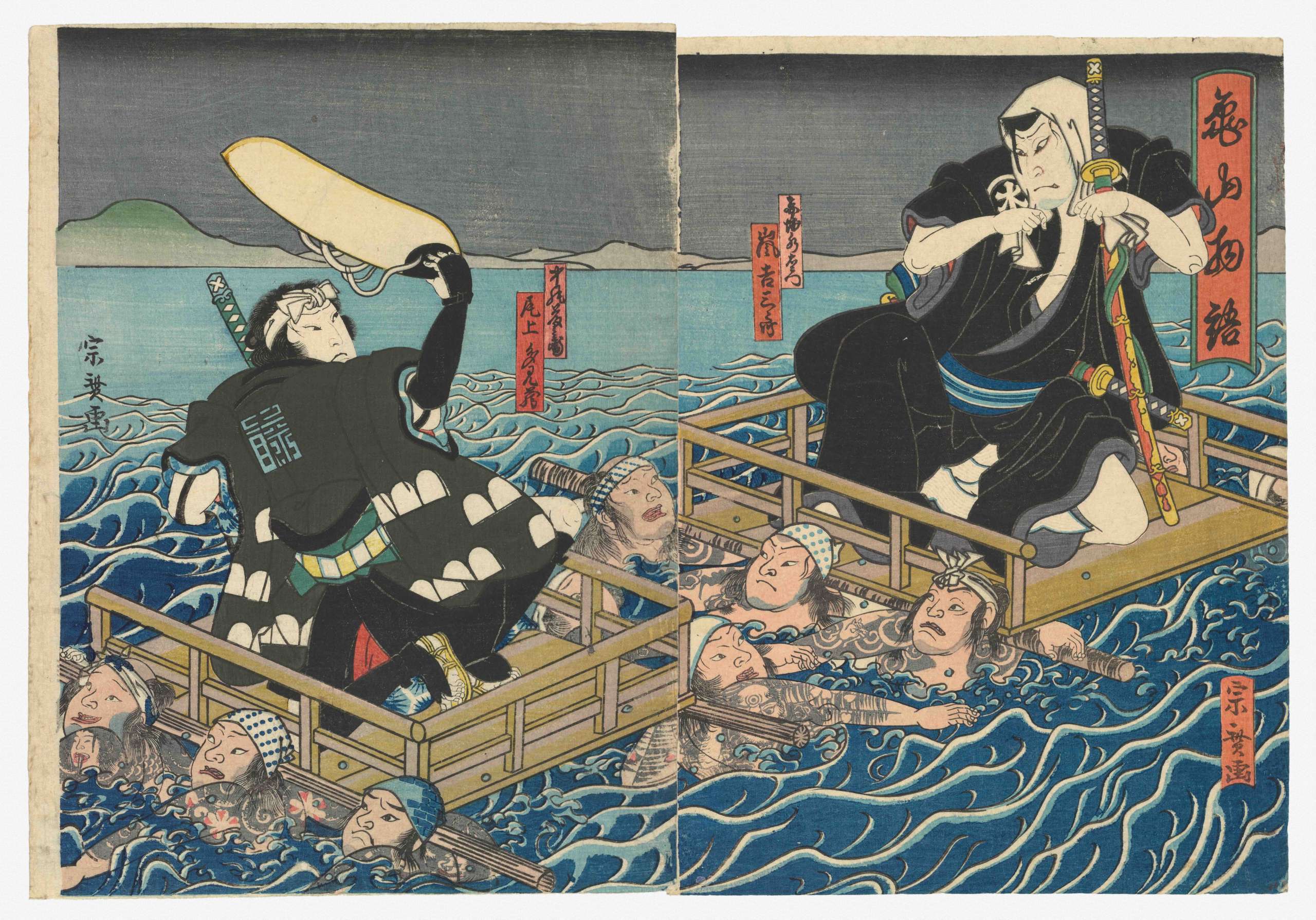
-
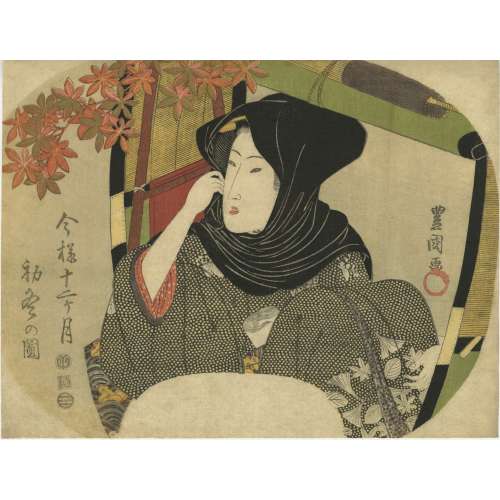 NEWTitle: Tenth lunar month (Shoto no zu) [初冬の図]. Series: Fashionable Twelve Months [今様十二ヶ月] (Imayo juni-kagetsu). Another version of the translation: Modern Beauties of Twelve Months. Artist: Utagawa Toyokuni I [歌川豊国] (1769–1825). Signed: Toyokuni ga [豊国画] and sealed with toshidama. Pubisher: Ibaya Senzaburō [伊場屋仙三郎] (Japanese, 1815 – 1869), seal: Dansendō [伊場仙]. Date-kiwame seal: Ushi (ox), Bunsei 5 (1822). Size: double-sheet uncut fan print (aiban uchiwa-e), each 220 x 289 mm.
NEWTitle: Tenth lunar month (Shoto no zu) [初冬の図]. Series: Fashionable Twelve Months [今様十二ヶ月] (Imayo juni-kagetsu). Another version of the translation: Modern Beauties of Twelve Months. Artist: Utagawa Toyokuni I [歌川豊国] (1769–1825). Signed: Toyokuni ga [豊国画] and sealed with toshidama. Pubisher: Ibaya Senzaburō [伊場屋仙三郎] (Japanese, 1815 – 1869), seal: Dansendō [伊場仙]. Date-kiwame seal: Ushi (ox), Bunsei 5 (1822). Size: double-sheet uncut fan print (aiban uchiwa-e), each 220 x 289 mm.
Other five prints of this series: SVJP 0326.2020; SVJP-0362.2022; SVJP-0363.2022; SVJP-0364.2022; SVJP-0365.2022; SVJP-0379.2022.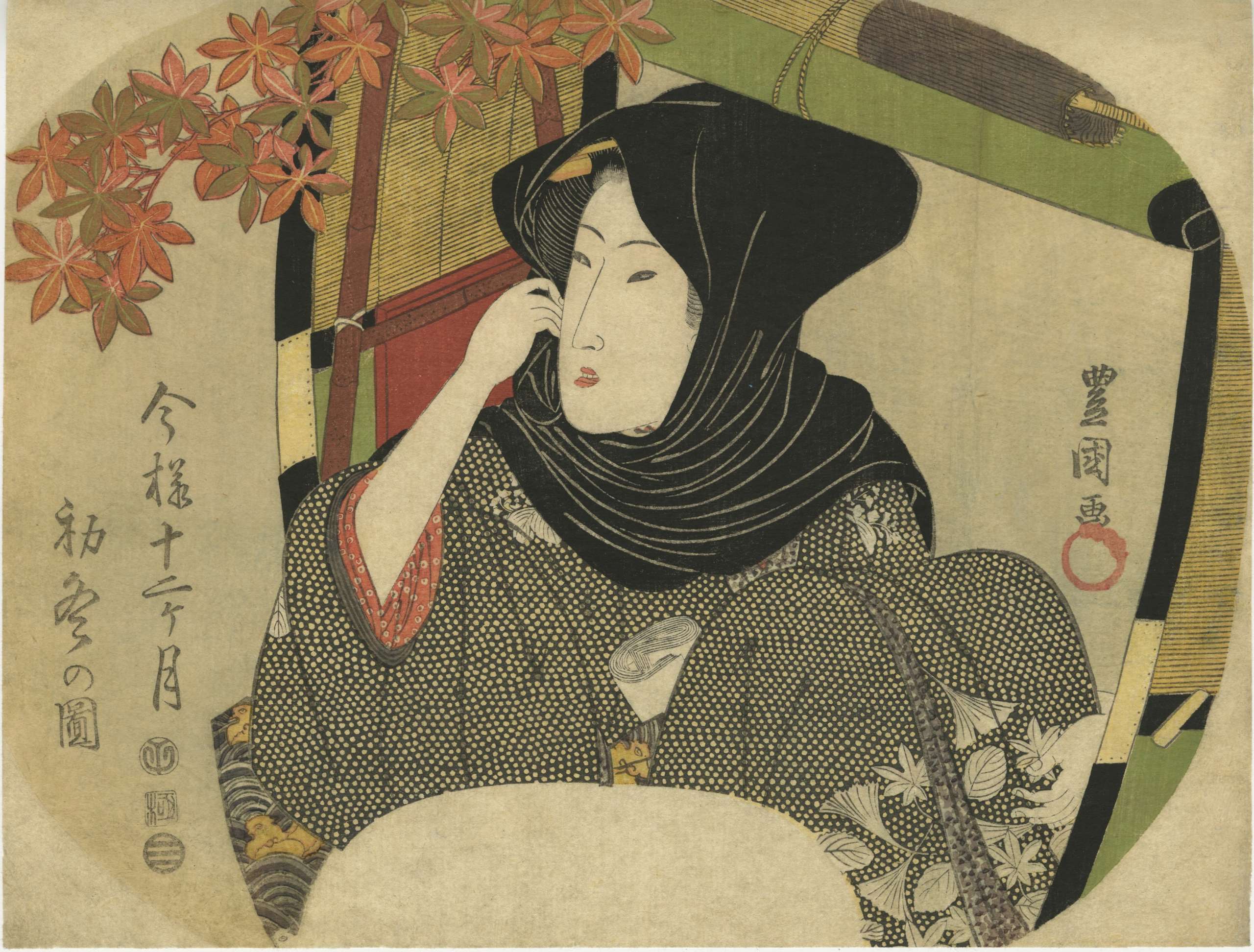

-
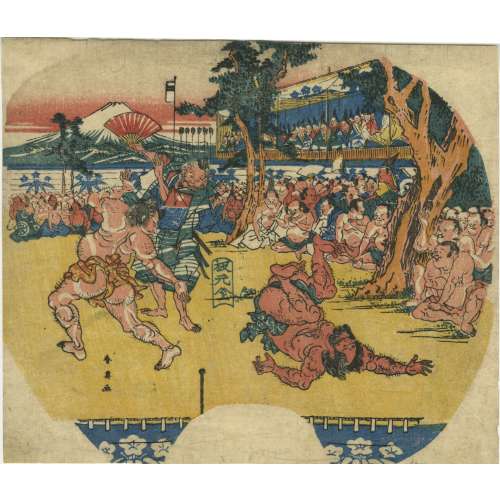 NEWArtist: Katsukawa Shun'ei [勝川 春英] (Japanese, 1762 – 1819) Signature: Shun'ei ga [春英画] Dimensions: Aiban yoko-e uchiwa-e, 230 x 268 mm. Censor seal: absent (probably because before 1810). Publisher: Iseya Sōemon – 板元,上, Marks 21-216|156g: Hanmoto, Ue. A blue seal in the middle of the print.
NEWArtist: Katsukawa Shun'ei [勝川 春英] (Japanese, 1762 – 1819) Signature: Shun'ei ga [春英画] Dimensions: Aiban yoko-e uchiwa-e, 230 x 268 mm. Censor seal: absent (probably because before 1810). Publisher: Iseya Sōemon – 板元,上, Marks 21-216|156g: Hanmoto, Ue. A blue seal in the middle of the print. -
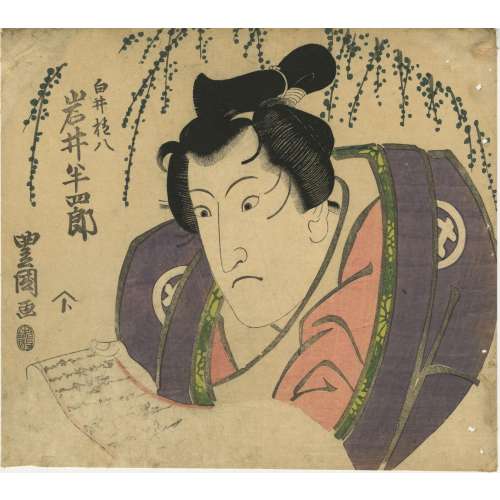 NEWKabuki actor Iwai Hanshiro V, in the role of Shirai Gonpachi, stands under a willow tree (yanagi, 柳) to read a letter from the courtesan Komurasaki of the Miuraya [三浦屋小紫]. In this letter, Komurasaki laments their unfortunate love. This is a scene from the kabuki play The Floating World's Pattern and Matching Lightning Bolts (Ukiyozuka hiyoku no inazuma) [浮世柄比翼稲妻] written by Tsurya Namboku IV [鶴屋南北]; it was played for the first time in March 1823 at Ichimura Theatre [市村座] in Edo. This play was later divided into two individual pieces: Saya-ate [鞘当] and Fuwa [不破]. On the shoulders of the actor's garment is a character 井 in a circle — both names, Iwai 岩井 and Shirai 白井, use this character.
NEWKabuki actor Iwai Hanshiro V, in the role of Shirai Gonpachi, stands under a willow tree (yanagi, 柳) to read a letter from the courtesan Komurasaki of the Miuraya [三浦屋小紫]. In this letter, Komurasaki laments their unfortunate love. This is a scene from the kabuki play The Floating World's Pattern and Matching Lightning Bolts (Ukiyozuka hiyoku no inazuma) [浮世柄比翼稲妻] written by Tsurya Namboku IV [鶴屋南北]; it was played for the first time in March 1823 at Ichimura Theatre [市村座] in Edo. This play was later divided into two individual pieces: Saya-ate [鞘当] and Fuwa [不破]. On the shoulders of the actor's garment is a character 井 in a circle — both names, Iwai 岩井 and Shirai 白井, use this character.
More information about the play and the real story behind it can be found at Lyon Collection. Actor: Iwai Hanshirō V [岩井半四郎] (Japanese, 1776 – 1847); other names: Iwai Tojaku, Iwai Kumesaburō I. Role: Shirai Gonpachi [白井権八] Artist: Utagawa Toyokuni I [歌川豊国] (1769–1825). Signed: Toyokuni ga [豊国画]. Publisher: Enshūya Matabei [遠州屋又兵衛] (Enterprise, active c. 1768 – 1881); seal: “to” (ト) under roof (Marks 01-031 | 057a). Date-aratame censor seal: 未改, Bunsei 6 (1823). Media: Aiban yoko-e uchiwa-e 団扇絵), 233 x 260 mm."Ukiyozuka Hiyoku no Inazuma" is a kabuki play in nine acts, written by Tsuruya Nanboku IV. It premiered in Bunsei 6 (1823) at the Ichimura-za theatre in Edo.
The play includes two particularly famous scenes:
- "Suzugamori no ba" (The Scene at Suzugamori), which portrays the episode of Banzuiin Chōbei and Shirai Gonpachi
- "Yoshiwara Nakanochō no ba" (The Scene at Yoshiwara Nakanochō), which depicts the story of Nagoya Sanza and Fuwa Banzaemon
These scenes have been frequently performed under the well-known titles "Gozonji Suzugamori" (A Well-Known Suzugamori) and "Sayaate" (The Scabbard Clash).
-
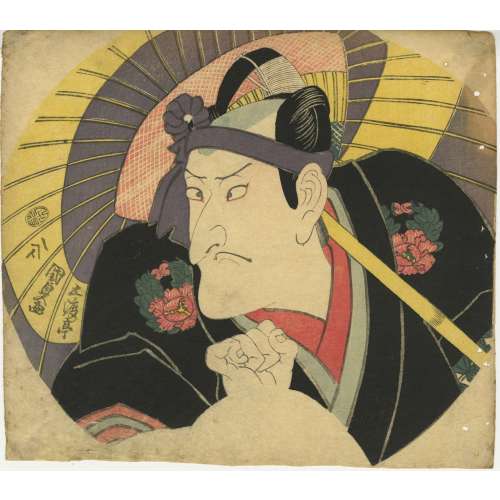 NEW
NEWArtist: Utagawa Kunisada [歌川 国貴] a.k.a. Utagawa Toyokuni III [三代歌川豐国] (Japanese, 1786–1865)
Publisher: unknown (Ichi-To, 未詳); Marks 05-012 | U085a; seal (一、ト). Date-aratame seal: Bunsei 5 (文政五年, 1822). Media: Fan print (Aiban yoko-e uchiwa-e, 合別横絵団扇絵); 234 × 264 mm. Actor: Matsumoto Kōshirō V [五代相本幸四郎] (Japanese, 1764–1838); other names: Ichikawa Komazō III [市川高麻蔵], Ichikawa Sumizō I [市川寿美蔵]. Role: Hanakawado no Sukeroku [花川戸の助六]. Play: Sukeroku sakura no futae obi [助六桜の二重帯].This bust-length portrait depicts kabuki actor Matsumoto Kōshirō V in the role of Hanakawado no Sukeroku under a vast umbrella, in a three-quarter view, facing right, with his fist firmly clenched, and with an expression of intensity and determination. His protuberant nose is accentuated, a defining feature of Matsumoto Kōshirō V. The actor wears a black outer robe adorned with stylized peonies (牡丹, botan), a floral motif symbolizing strength, nobility, and elegance—qualities that define both the Sukeroku character and Kōshirō V’s acting style. The print belongs to the yakusha-e (役者絵, "actor print") genre, celebrating kabuki stars of the Edo period. The artist's signature, publisher’s seal, and censor’s seal are written on the umbrella. Play Sukeroku sakura no futae obi was staged in March 1822 (Bunsei 5) at Kawarazaki Theater (歌川戸室) in Edo (Tokyo). In this version of the Sukeroku narrative, the protagonist is revealed to be Jirō Suketoshi of Kyoto [京の次郎祐俊], a nobleman in disguise. Like other Sukeroku adaptations, the story centres on themes of chivalry, revenge, and romantic rivalry in Edo’s pleasure quarters. Another Kunisada's portraits of Matsumoto Kōshirō V as Sukeroku, in Ōban format:
The History of Sukeroku in Kabuki Theater
The play Sukeroku (English title Sukeroku: Flower of Edo), originally titled Hana Yakata Aigo Zakura (花館愛護櫻), premiered in the 3rd lunar month of 1713 at Yamamuraza in Edo. The script was written by Tsuuchi Han'emon (津打半右衛門) under the guidance of Tsuuchi Jihē II (津打治兵衛, 1679–1760). The inaugural performance featured Ichikawa Danjūrō II as Sukeroku, Tamazawa Rin'ya as Agemaki, Ikushima Shingorô as the shirozake seller (白酒売り) Shinbē, and Yamanaka Heikurô I as Ikyū. Three years later, in 1716, Tsuuchi Jihē II revised the play, integrating it into the well-known Soga brothers' revenge tale. In this adaptation, Sukeroku, Agemaki, and Shinbē were revealed to be Soga Gorō Tokimune, the courtesan Kewaizaka no Shōshō, and Soga Jūrō Sukenari, respectively. This revised version was staged at Nakamuraza in the 2nd lunar month of 1716, with Ichikawa Danjūrō II reprising the role of Sukeroku, joined by Nakamura Takesaburô I (Agemaki), Mimasuya Sukejûrô I (Shinbē), Sodeoka Masanosuke II (Soga’s mother Mankō), and Ôtani Hiroemon I (Ikyū). Over time, Sukeroku became closely associated with the Ichikawa Danjūrō acting lineage, captivating Edo audiences and securing its place in the kabuki repertoire. Though traditionally performed by members of the Naritaya guild, the role of Sukeroku was occasionally played by actors from outside the Ichikawa family. The play was later staged under the title Sukeroku Yukari no Edo Zakura for the first time in the 4th lunar month of 1782 at Ichimuraza, with Ichimura Uzaemon IX portraying the titular role. Comparison to Toyokuni I’s 1816 Print Kunisada’s portrait can be viewed as a homage to his mentor, Utagawa Toyokuni I [初代歌川豊国] (1769–1825), whose earlier 1816 bust-length portrait of Iwai Hanshirō V [岩井半四郎] as Sukeroku (published by Ibaya Senzaburō [伊場屋仙三郎]) shares a similar composition and dramatic pose. While Matsumoto Kōshirō V’s portrayal (Kunisada, 1822) emphasizes power and masculinity through the peony motif, Iwai Hanshirō V’s 1816 version (Toyokuni I) reflects grace and refinement, featuring a kimono adorned with irises (菖蒲, shōbu)—a flower symbolizing purity and elegance. Additionally, the word shōbu (iris) is a homophone for 尚武, meaning "martial spirit", subtly reinforcing Sukeroku’s strength beneath his stylish exterior. These contrasts highlight the differences in kabuki acting styles—with Kōshirō V specializing in strong, heroic roles and Hanshirō V excelling in onnagata (female-role) performances. -
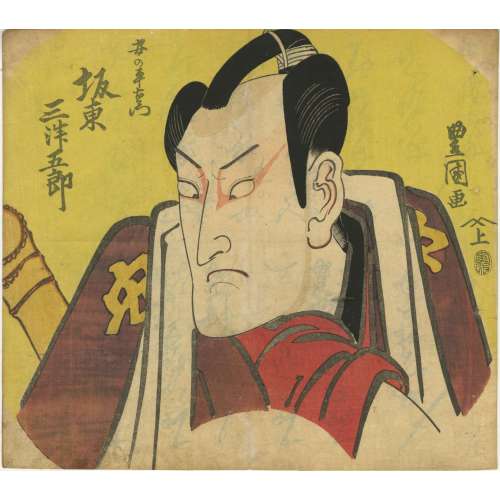 NEW
NEWArtist: Utagawa Toyokuni I [初代豊国] (Japanese, 1769–1825)
Publisher: Iseya Sōemon [伊勢屋惣右衛門] (c. 1776 – November 1862); Marks 02-041 | 156a
Date-Aratame Seal: Bunsei 1 (文政元年, 1818)
Media: Print (Yakusha-e, 役者絵); 223 x 250 mm
Actor: Bandō Mitsugorō III [三代目 坂東 三津五郎] (Japanese, 1775–1831); also known as Bandō Minosuke I, Morita Kanjirō II, Bandō Mitahachi I, Bandō Minosuke I, Bandō Mitahachi I.
Role: Anno Heiemon [安の平右衛門], also known as Anno Heibei [安の平兵衛].
Play: Shiire Zome Karigane Gomon [仕入染雁金五紋] (しいれぞめかりがねごもん), staged in May 1818 at Nakamuraza Theatre in Edo (modern-day Tokyo).
Bust-length, three-quarter-view portrait of actor Bandō Mitsugorō III as Anno Heibei, one of the gonin otoko [五人男]—a group of five chivalrous thieves. The actor is dressed in a red and purple robe, with a golden mon (family crest) on the shoulders, displaying the character 安 (An), which, in this case, represents the first ideogram in the name of his role. A shakuhachi (尺八), a traditional Japanese end-blown bamboo flute, is secured on his back.
-
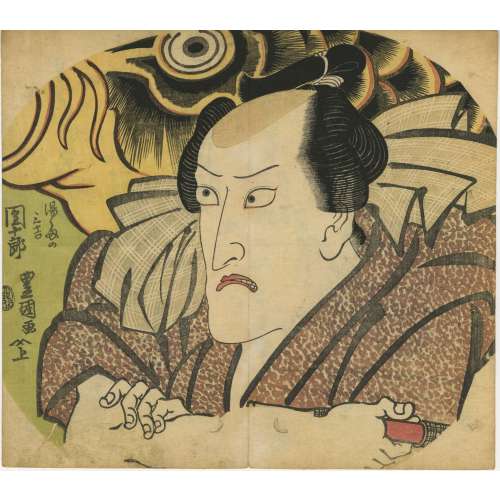 NEWArtist: Utagawa Toyokuni I [初代豊国] (Japanese, 1769–1825) Signed: Toyokuni ga [豊国画]. Publisher: Iseya Sōemon [伊勢屋惣右衛門] (c. 1776 – November 1862); Marks 02-041 | 156a Date-Aratame Seal: 1819 (Bunsei 2, 文政二年) Media: Print (Yakusha-e, 役者絵); 221 x 253 mm
NEWArtist: Utagawa Toyokuni I [初代豊国] (Japanese, 1769–1825) Signed: Toyokuni ga [豊国画]. Publisher: Iseya Sōemon [伊勢屋惣右衛門] (c. 1776 – November 1862); Marks 02-041 | 156a Date-Aratame Seal: 1819 (Bunsei 2, 文政二年) Media: Print (Yakusha-e, 役者絵); 221 x 253 mmActor: Ichikawa Danjūrō VII [七代目市川團十郎] (Japanese, 1791–1859); Other names: Ichikawa Ebizō V (五代目市川海老蔵), Ichikawa Hakuen II (二代目市川白猿), Ichikawa Shinnosuke I (初代市川新之助).
Role: Yushima no Sankichi (ゆしまの三吉) Play: Ume Yanagi Wakaba no Kagazome (梅柳若葉加賀染) Theater: Tamagawa-za (玉川座), Edo, May 1819 Bust-length, three-quarter-view portrait of Ichikawa Danjūrō VII as Yushima no Sankichi, in the play Ume Yanagi Wakaba no Kagazome, staged at Tamagawa-za in May 1819. The actor is depicted with his arms crossed over his chest, holding a pipe (kiseru, 煙管) in his right hand. The upper half of the background features a giant golden carp (鯉, koi), symbolizing Boys' Day (Tango no Sekku) (端午の節句), celebrated on May 5th each year. This print forms a pair with the portrait of Kabuki actor Segawa Kikunojō V as Kurenaiya Okan [SVJP-0440.2025], but no conclusive information is available regarding the relationship between their characters.